Union Steam Ship Company,
the great RMS Aorangi 1924 to 1953
Please
Note: Mobiles,
Firefox & Google Chrome other search engines may not suitable
Please
use Internet
Explorer or Old Google for this page to load perfectly!

Click
the logo above to reach the ssMaritime FrontPage for New Features & Updates
With
Reuben Goossens
Maritime
Historian,
Author, Cruise‘n’Ship Reviewer and Maritime Lecturer
Please
Note: All ssMaritime and other related maritime
& cruise sites are 100% non-commercial and privately owned. Be assured that
I am NOT associated with any shipping or cruise companies or travel or cruise
agencies, etc! Although having been in the passenger shipping industry since 1960,
I am now retired but having completed features on well over 700 Classic Liners
and Cargo-Passengers Ships, I trust these will continue to provide you the
classic ship enthusiast the information you are seeking, but above all a great
deal of pleasure!
Union Steam
Ship Company
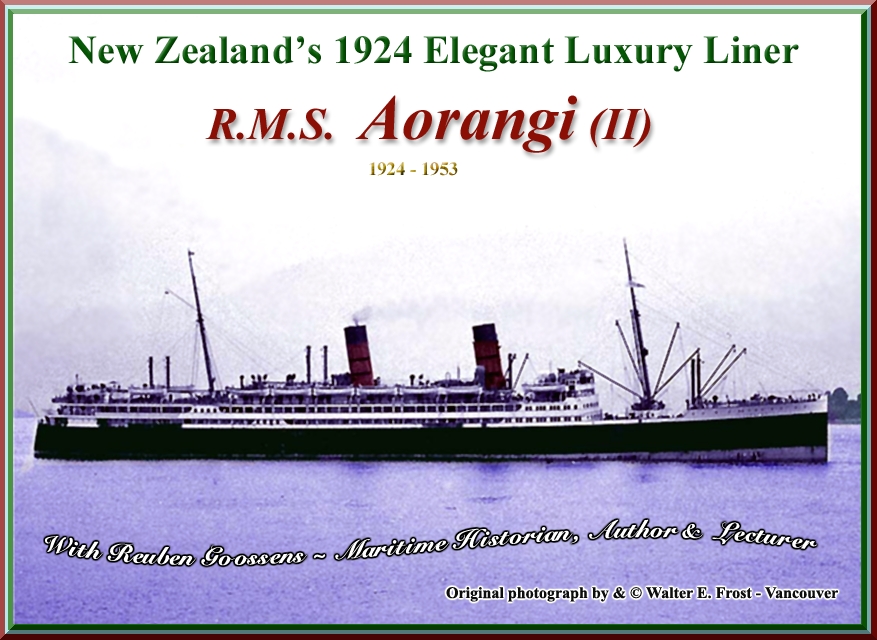
Please Note: Photographs and
images on this feature are from the author’s private maritime collection,
Andrew Deans & family, or as stated otherwise!
Introduction:
The
Union Steam Ship Company (USSCo) is a well established British/New Zealand
Shipping Company with a huge list of ships to its name, both cargo and
passenger liners. There were some very small ones in the early days, including
the combination sail and steamship the Aorangi,
built in 1983, but obtained by the USSCo in 1910. These were the early days of
a company that would go on and build wonderful and enduring ships such as the
7,527 GRT (Gross Registered Tons) as the SS Maunganui (1911-1948), which was
sold to a Greek company and was renamed Cyrenia (1948-1957), then came the
largest and the most glamorous to date, the luxurious 13,415 GRT SS Niagara
(1914-1940), followed by the remarkable but slightly smaller and enduring of
line 4,436 GRT SS Wahine (1913-1951).
However, it would not be until a good ten
years after the Wahine, in 1923 that the company laid plans for a brand new
much larger liner and gave the order for this ship to be built to Fairfield
Shipbuilding & Engineering Company in Glasgow, Scotland and soon
“Hull 603” commenced, she would become RMS Aorangi II.
I trust that you will enjoy this new feature,
which is one I am writing during my official retirement, when I should be
resting more. But, it is good to keep on doing something occasionally - Right?
But first, let us first look at the SS Aorangi 1.
Reuben Goossens.
**********************
S.S.
Aorangi (I):
The first S.S.
Aorangi was built by John Elder & Co in Glasgow
for the New Zealand Shipping Company and she was launched on October 2, 1883.
This delightful 4,162 GRT three mast, clipper bow ship had a single funnel, and
was fitted with refrigerated cargo space. Her three decks accommodated 80 First
Class, 80 Second Class and 250 in Third Class passengers.
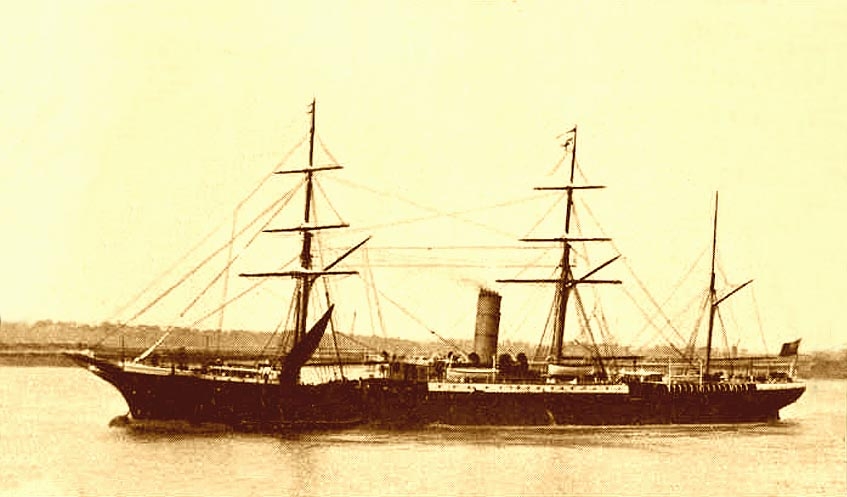
Here
we see the S.S. Aorangi as built with a full rigging for sails and a shorter
funnel
Part
of a private collection of a series of old sepia photographs © R. Goossens
She
was especially built to operate between England and New Zealand
for the New Zealand Shipping Company, who would own her from 1883 to 1996, but
in 1894, she was chartered to the Australian Huddart Parker Shipping line.
She was obtained by the
Canadian Australian Royal Mail Line in 1896 who decided to give her a refit,
which was completed in 1897, externally this saw her funnel heightened by a
good 10ft - 3.05m taller as well as accommodation updates that included 100
First Class and 50 Second Class berths. She recommenced, but on a new service
under the New Zealand Line, and this was the popular Pacific route from San Francisco to Sydney sailing via some Pacific Islands and New Zealand.
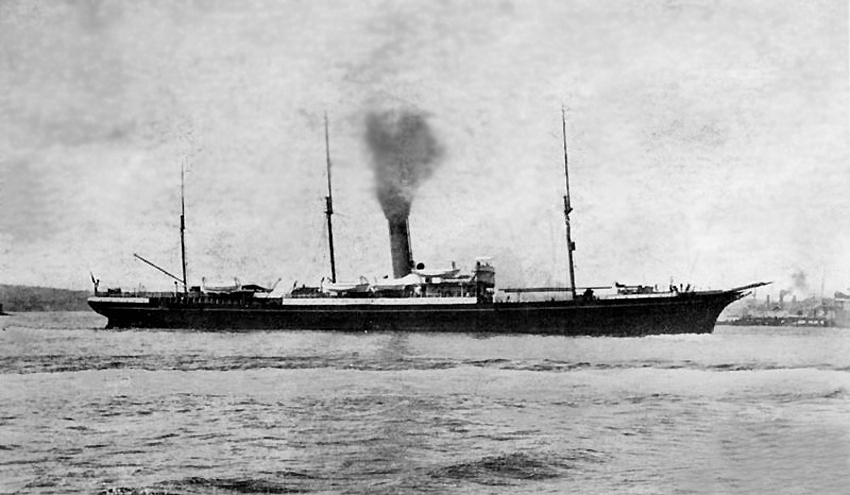
S.S.
Aorangi seen around 1907 quite some time after her refit, with
her rigging removed and her funnel heightened
In
1910, The Union Steam Ship Co (USSCo) of New Zealand became her official
owners, but her service remained the same, and she continued on this service
until late March 1914, when she arrived in Sydney and she was laid up for a
refit, as she had been chartered by the Royal Australian Navy for war duties
until 1915.
Having been fitted out she was
used as a supply ship, but she was never officially commissioned into the Royal
Australian Navy and she was manned by her New Zealand
civilian crew. Yet, she was well armed with a QF 12 pounder 12 cwt naval gun and
she took part in various operations against the German colonies in the Pacific
with the Australian Naval and Military Expeditionary Force and Australian
Fleet.
The Aorangi was returned to the USSCo in May
1915, but they sold her directly to the Admiralty, who had took her to Britain
and scuttled her in August 1915, in Holm Sound, Scapa Flow, the United
Kingdom’s chief naval base during World War I. She was salvaged,
refloated in 1920, cleaned, and made ready to be used as a storage ship at Malta
until she was scrapped in 1925.
Aorangi II - Construction,
Launching, Fit-Out and Sea-trails:
USSCo
ordered a new larger liner to be built by Fairfield Shipbuilding &
Engineering Co., Ltd., Glasgow, Scotland, and
her keel was laid down in 1923. She was launched and named
‘Aorangi’ on June 17, 1924 and was officially christened with these
words; “I name this ship the Aorangi”
as spoken by Mrs Charles Holdsworth, who was the wife of USSCo’s Managing
Director Mr. Charles Holdsworth. A special gavel was used by Mrs
Holdsworth to launch the ship and upon the conclusion of the vent, the gavel
was presented to her, placed in a specially carved box with a painting of the
RMS Aorangi inside of the lid (by
an unknown artist), and this item is now in the
possession of her surviving relatives, being the Deans family, together with a
small painting of the Aorangi by the celebrated maritime artist Charles Dixon.
Launching Photographs:
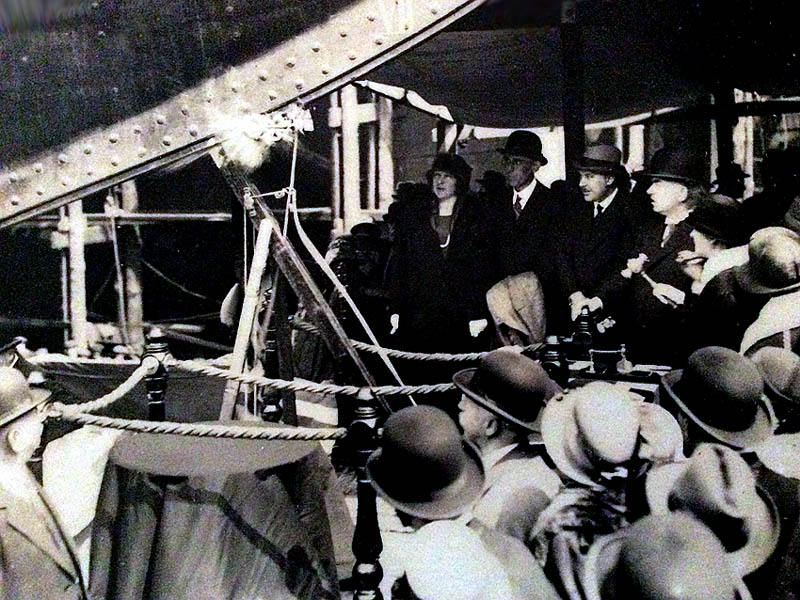
Here we
see Mrs Charles Holdsworth (later Lady Holdsworth) having used the gavel and
the bottle is smashing against the bow
Pease Note: All photographs related to
the launching of the RMS Aorangi, were kindly provided by Andrew Deans, and the
Deans family
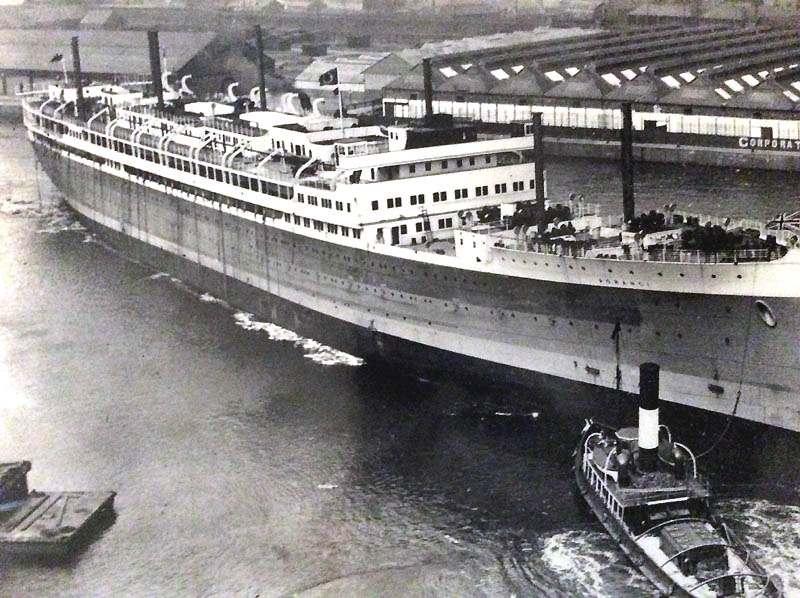
The new
liner slides into the Clyde
and will be be taken in tow and moved to her fit-out
berth
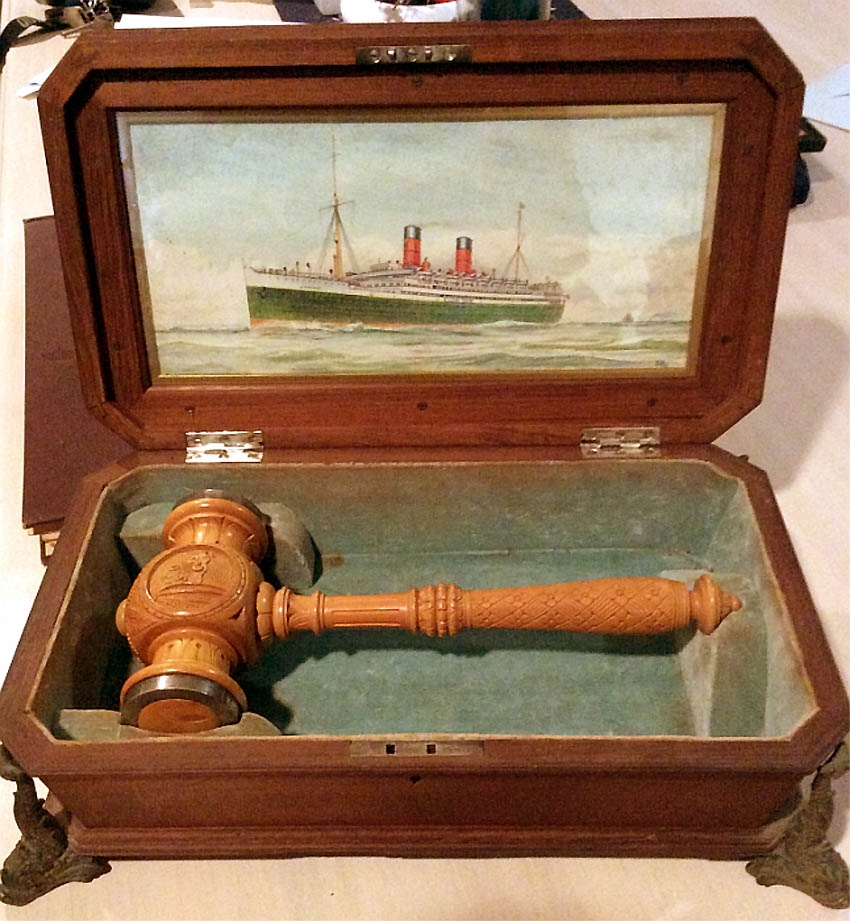
Above
& below; the gavel and box presented to Mrs.
Charles Holdsworth after her launching of the Aorangi
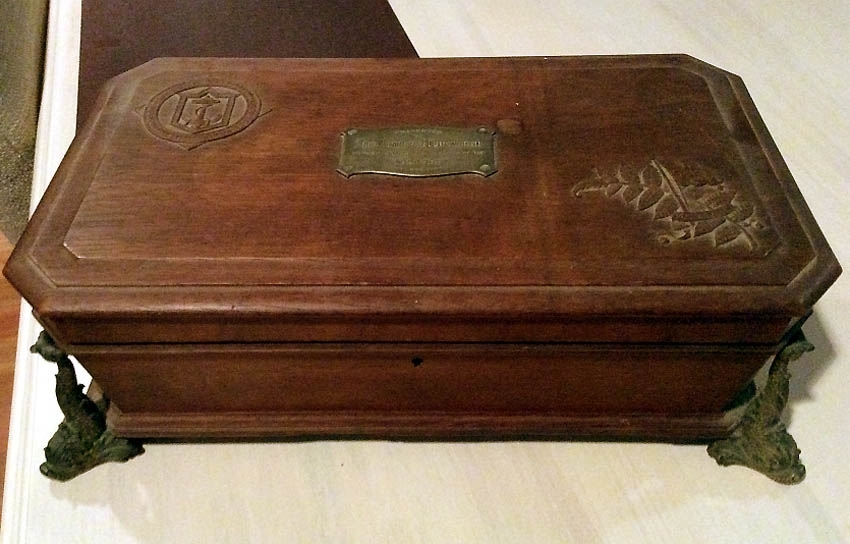
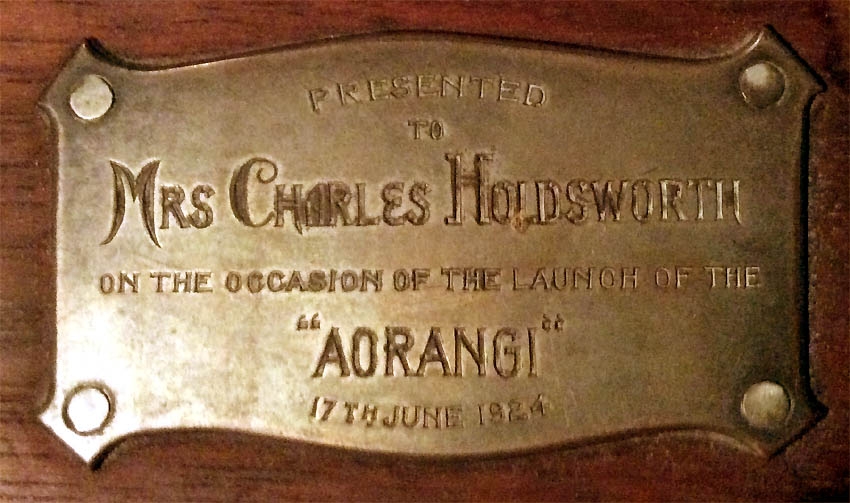
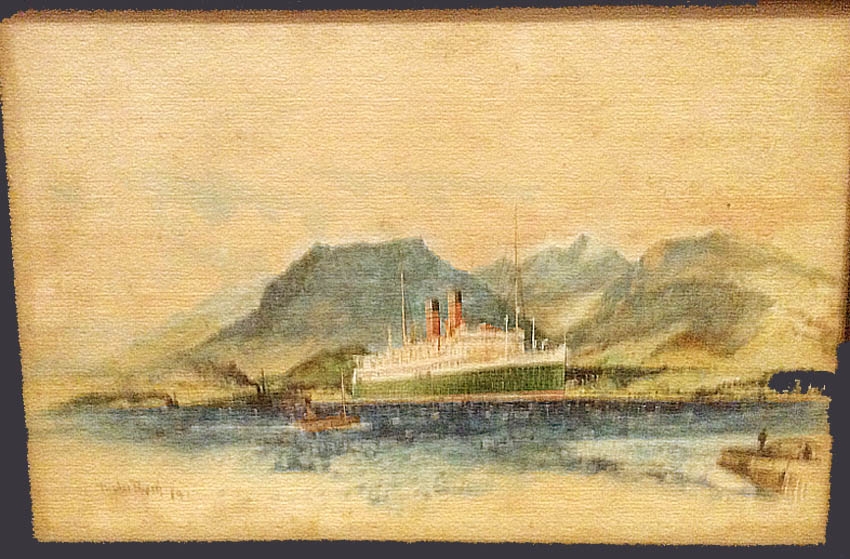
A painting
of the RMS Aorangi by Charles Dixon
For Interest: The
name ‘Aorangi’ was chosen as it is the Maori name for
‘Mount Cook,’ being New Zealand’s tallest mountain,
but in English the Maori word is in reality translated as ‘Cloud
Piercer,’ being a suitable name for the then revolutionary liner with her
stately tall funnels, as well as being the largest and fastest motor powered
ship in the world. PS: Aorangi
is also pronounced ‘Aoraki,’
the reason for the two names are due to the small differences in
pronunciation that occurred, between Maori tribes (iwi).
The Maoris local to the Mount Cook
area are the ‘Ngai Tahu’
tribe (iwi), and they pronounce it as ‘Aoraki.’
The Aorangi was fitted out on the Clyde where she was given some of the most
spectacular interiors, which were as good as many of the great Trans-Atlantic
liners of her time. Upon completion she underwent her comprehensive deep-sea
trails where she achieved an amazing 18.24 knots, and these sea trials were
expected during November and December. With this in mind, the Union Steam Ship
Company commenced forward planning of their schedules considering the arrival
of their new liner Aorangi, which would be entering her duties on the
Vancouver, Sydney,
Vancouver
service as soon as she arrived in Vancouver
Canada.
The RMS Aorangi was 17,491 GRT or a
displacement tonnage of 23,000 tons, which would place her, based on size as
well as her other qualities at the head and the largest of the merchant liners
trading on the South Pacific. This remarkable liner was fitted with quadruple
screws and was powered by four six-cylinder Fairfield built Sulzer ST70 two
stroke single acting engines of 700mm bore, a total of an excellent 13,000 BHP
at 127 RPM, and she had a service speed of 17.5 knots, and a maximum of 18.24
knots. At the time of her construction, she was the largest and fastest Motor
Ship in the world!
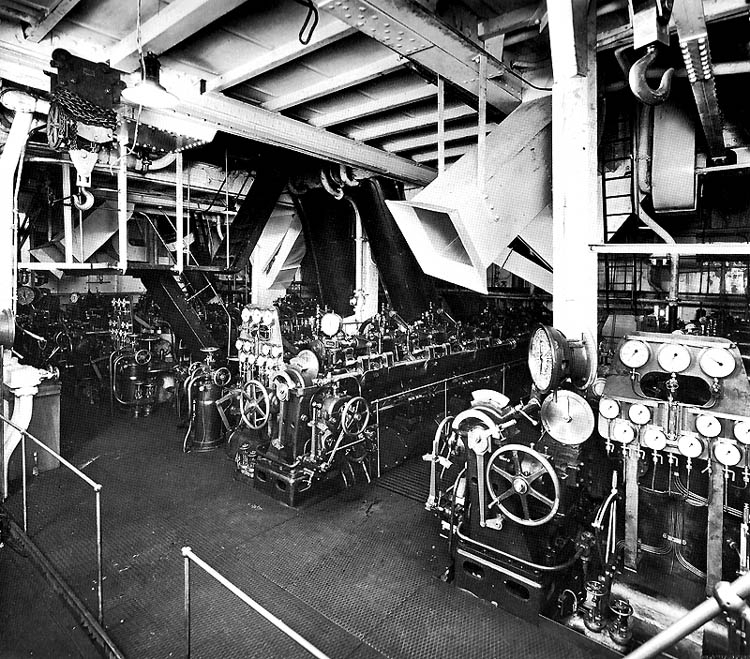
The
RMS Aorangi’s great Engine Room
Image was released by Fairfield Shipbuilding & Engineering
Company
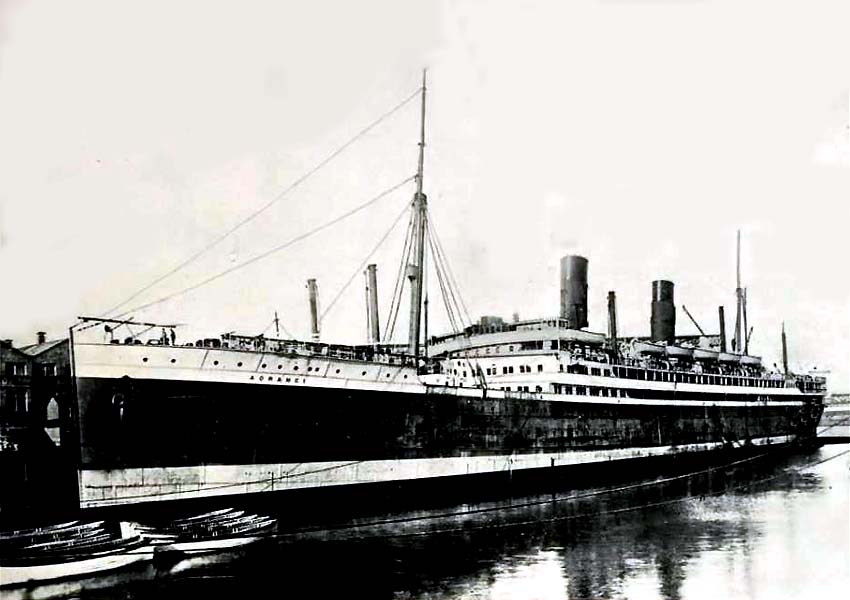
The
Aorangi is
seen here at the Fairfield Shipbuilding and Engineering Company Yards being
fitted out
Image was released by Fairfield Shipbuilding & Engineering
Company
Then in the second week of December 1924 the Aorangi commenced her sea trials and we are
told that she sailed a good 1,000 miles or 1,609.3 klm. Her tests were
described as “some of the most important in the history of the British
merchant marine.” The trials included operating the Aorangi under a number of conditions of fuel
consumption as well as speeds. Following her successful completion of these
trials it was decided that she would depart Southampton on January 2, 1925 on her maiden
voyage to Sydney Australia.
On December 16, 1924 some three hundred
invited guests for the society, engineering superintendents from the seventy
leading shipping companies were invited to take a short cruise on the Aorangi. Speaking at the luncheon, Sir
Alexander Fairfield said that in exhaustive trials the vessel had maintained 18
knots for 60 hours, which was remarkable!
As soon as people saw this ship there was no
doubt that she was more than an imposing passenger liner, for she did not just
have long sleek lines with her two well balanced tall red and black funnels,
two masts, and the traditional USSCo green hull, with a yellow ribbon running
all the hull, as well as that perfect cruiser stern and her all white
superstructure. All this created an imposing and a graceful profile, but moreso, her interiors were breathtakingly
beautiful and was praised by all!
RMS Aorangi the Ship:

As
built, on her six decks the Aorangi
offered accommodations for 970 passengers, with the ship having three classes;
440 Saloon, 300 Second Class and 230 Third Class Passengers and they were ably
looked after by a complement of 328 officers and crew. In addition to the
passenger accommodation there was a superb array of public rooms all designed
to offer stateliness and dignity using the very best designs of interior
furnishing and decoration offering the best of comforts regardless of class as
well as the finest hygienic practice of the period! It was obvious that the
latter was common to the detail of the ship's passenger accommodation down to
the corridors, bathrooms, and sanitary offices.
Eleven per cent of the total First Class
passengers had single berth cabins, whilst seventy-six per cent had two-berth
cabins. A large area of Promenade Deck close to the First Class Verandah Cafe
had been allotted and equipped for open-air dancing. Whilst during voyages
“moving pictures” (Movies) would be shown in one of the public
rooms.
The ship had facilities to carry 1,000 tons of
fresh water exclusively for drinking purposes. Although she was primarily
designed for passengers, the Aorangi
was also able to transport a considerable quantity of cargo in her eight holds,
which were equipped with 16 ‘silent winches.’ For interest, there
was a considerable refrigerated cargo space available to carry frozen meat
(mostly New Zealand
lamb), cheese, butter, and fruit.
RMS
Aorangi Photo Gallery
Saloon or
First Class
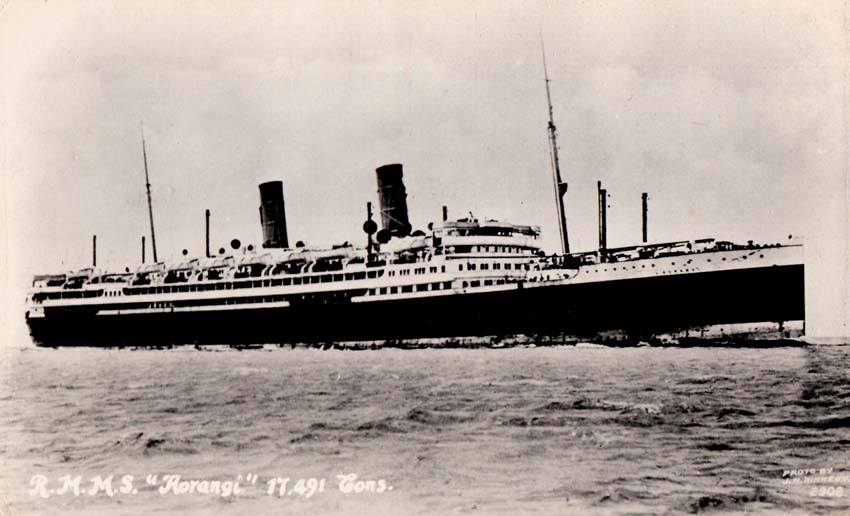
An
early Postcard of the stately RMMS Aorangi as was stated on this
card (Royal Mail Motor Ship)
Photograph
above and those interiors below are from the author’s private collection
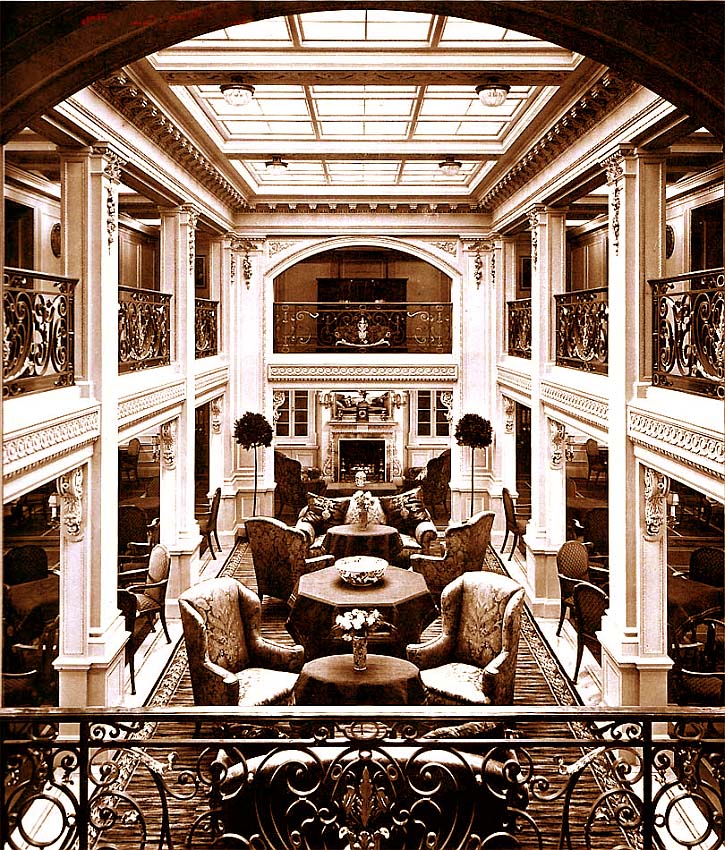
The
Main Lounge as seen from the balcony above
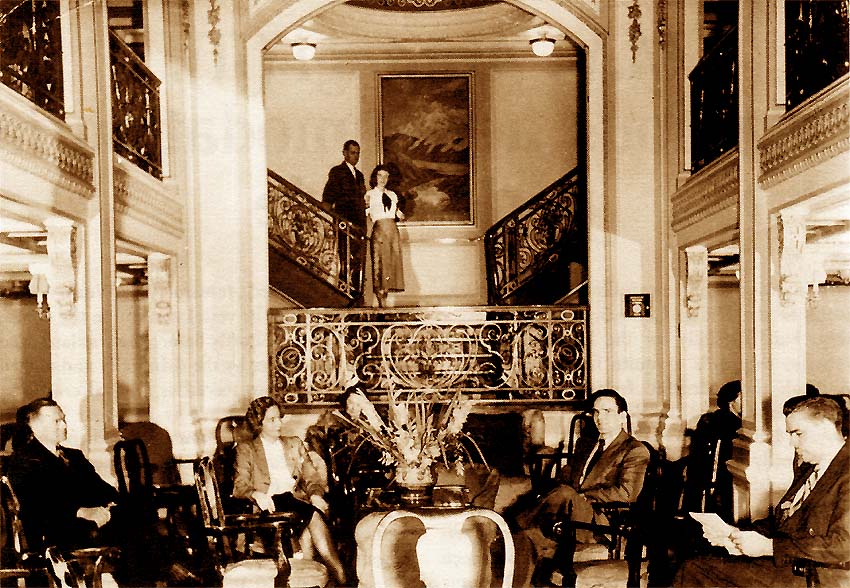
The
Georgian inspired Main Lounge
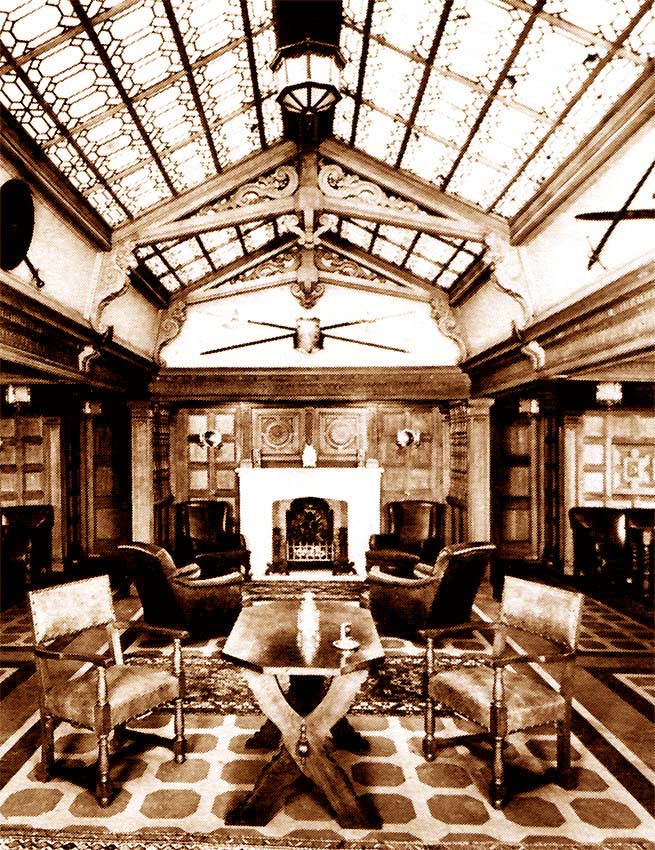
The
Jacobean inspired Smoking Room complete with a fireplace
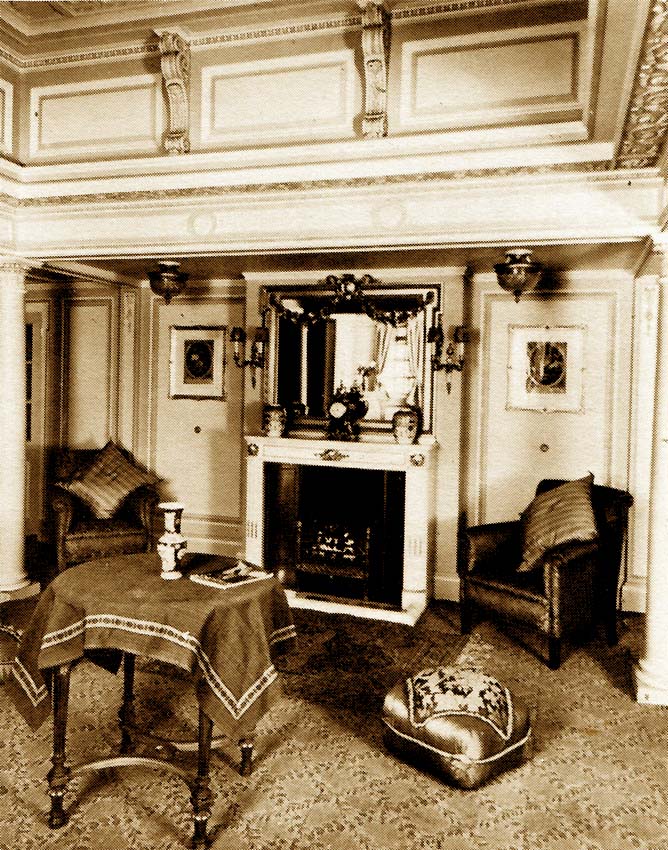
The
delightful cosy Music Room that was far more spacious than this
image suggests
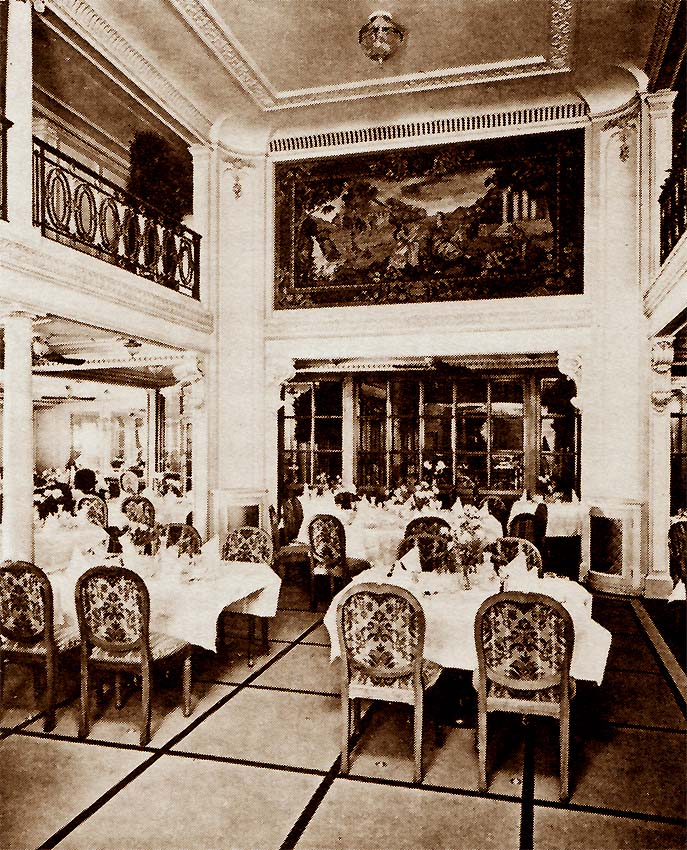
The
grandiose Dining Room had touches from the Louis XIV period
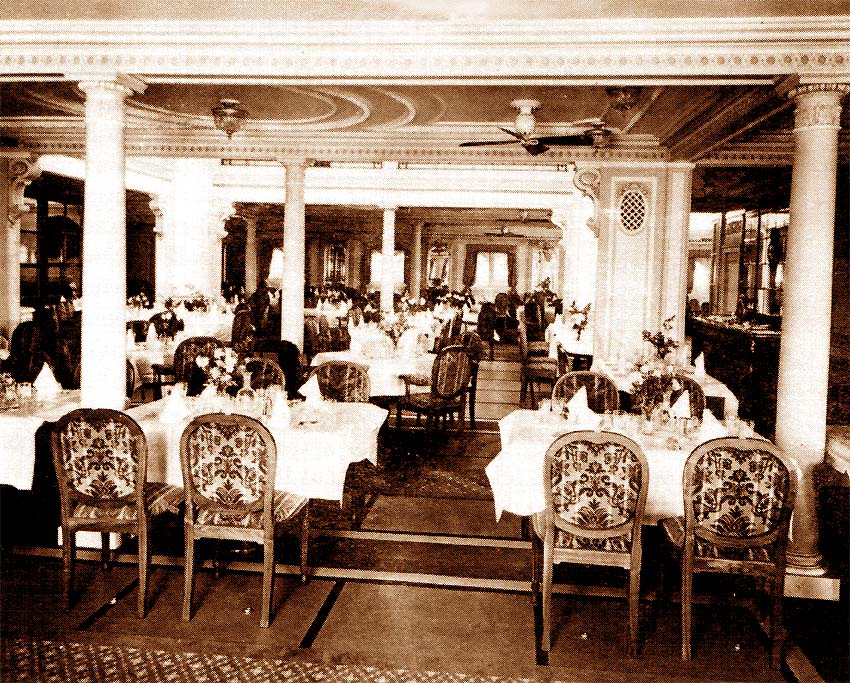
This
is the starboard side if the Dining Room looking towards port
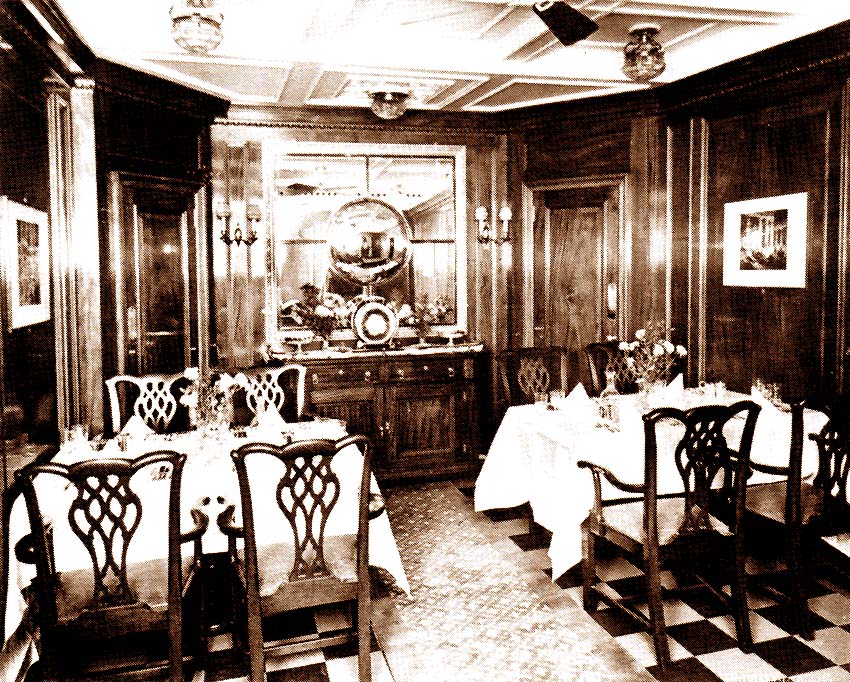
This
was the elegant private Dining Room for those who desired to have a meal alone,
or with friends
Thus
this was a prelude as to the optional dining that is has become so popular
today!
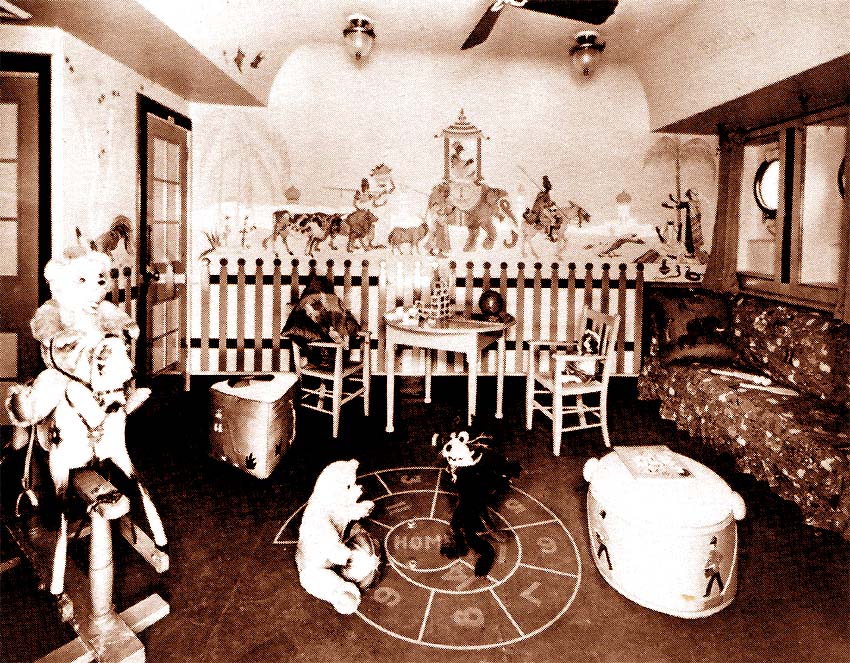
The
delightful Children’s Nursery and play area
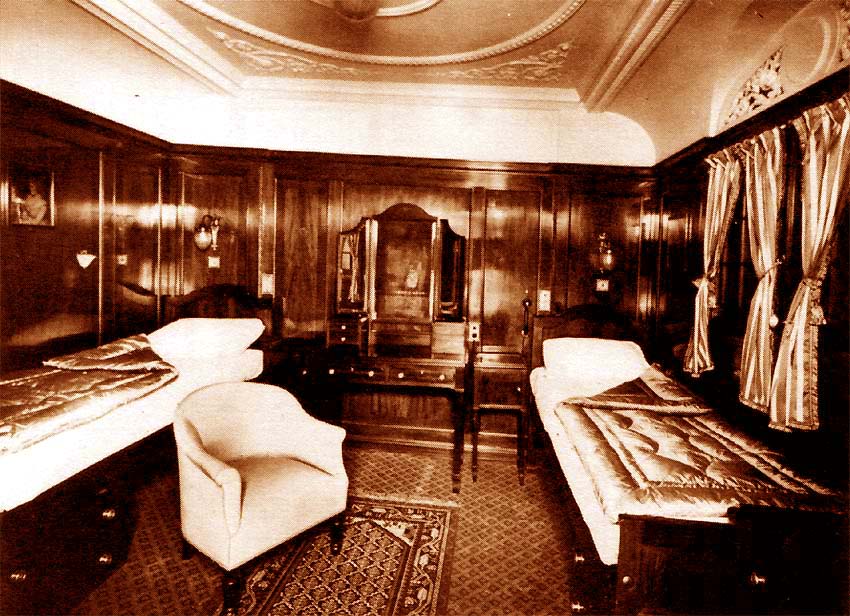
Here
we see a Deluxe Stateroom
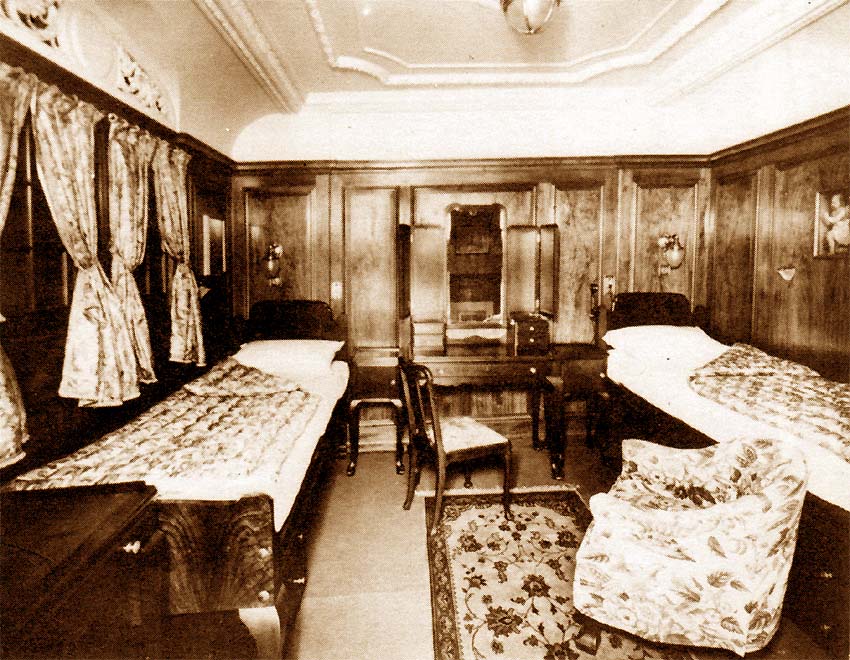
This
is a Deluxe Cabin
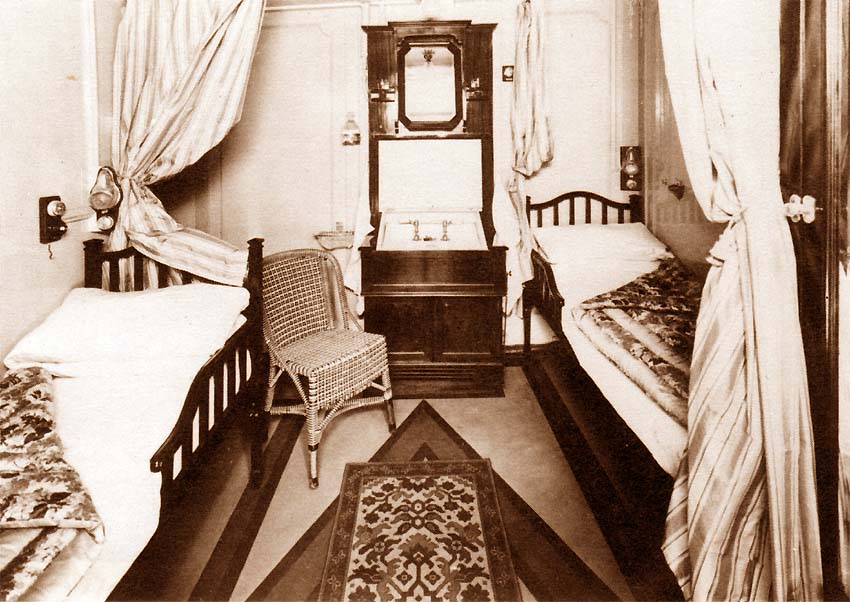
Amazingly
First Class did have some (unpopular) Inside Cabins
Second
Class
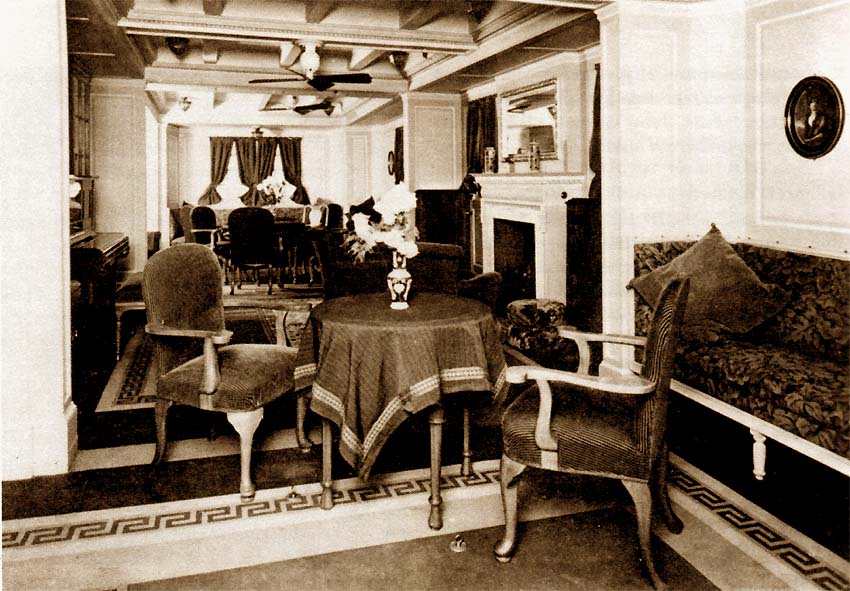
A
comfortable Lounge that is much larger than what is seen here
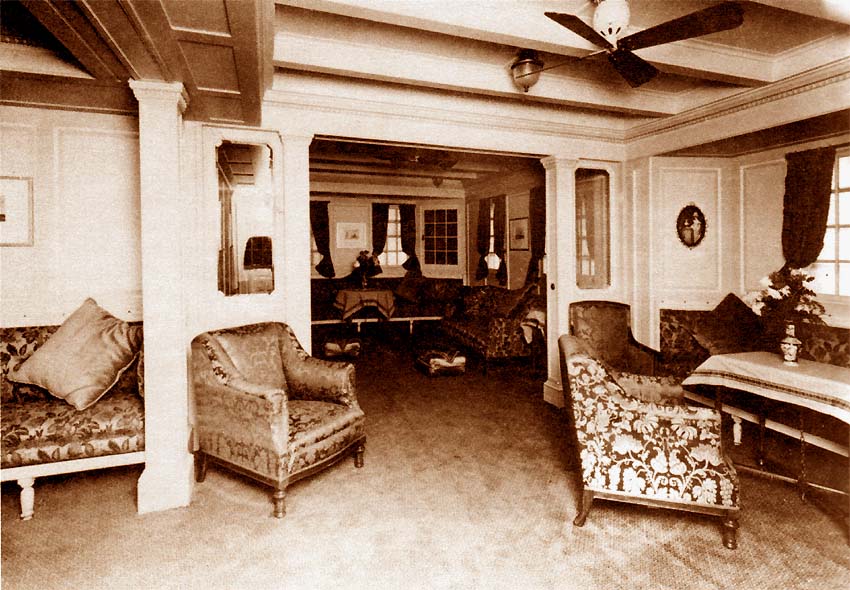
Like
in First Class here also was a delightful room just for the ladies
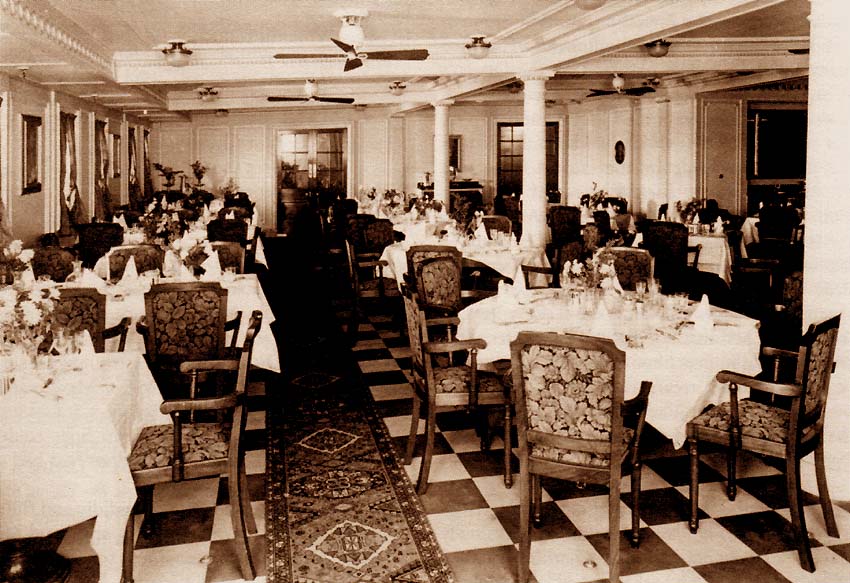
This
Dining Room would be as good as those on many First Class liners!
RMS Aorangi departs
on her Maiden Voyage:
She
commenced her maiden voyage from Southampton on January 2, 1925 and her
itinerary for the 17,000 mile - 27,359 klm passage included ports of call at;
Kingston, Colon, Bilbao, Panama Canal, Los Angeles, San Francisco, and
Vancouver, arriving there later that month on January 29.
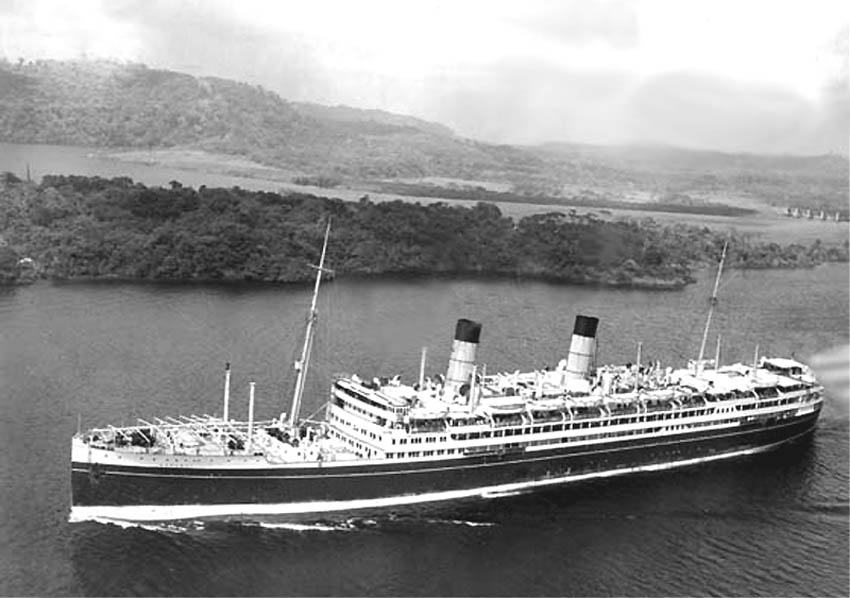
RMS
Aorangi seen during her maiden voyage in Gatun Lake, Panama
in January 1925
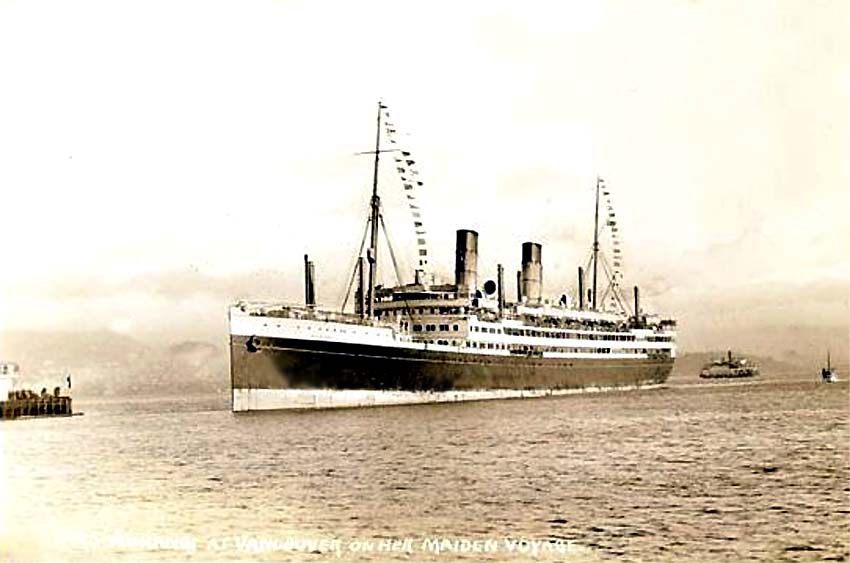
This
is a very rare marked photograph of the RMS Aorangi
at Vancouver on the
occasion of her maiden arrival
Sent
in by one of my Canadian supporters – name withheld by his request!
After a big welcome and a weel in Vancouver,
she departed for Auckland
and Sydney on
February 6, 1925 and Aorangi would follow the traditional
USSCo route to Honolulu,
as well as Suva
in Fiji
and she arrived in Auckland
on February 24, 1925.
Aorangi’s maiden
arrival in Auckland:
On February 24, 1925, the people of Auckland
were very excited that they were about to be the very first *Kiwi’s to
see this wonderful new liner that was now gently sailing past Rangitoto Island
up Auckland Harbour heading for Queen’s Wharf and as they looked at her,
some were thinking “She looks so stately,” and the crowds became
more and more exited the closer the ship came closer and some people were heard
to say; “Is she not the most beautiful ship ever?”
Of course, this was indeed a very special even
for Auckland, for most new USSCo ships on their maiden voyages tended to call
on Wellington first in the past, thus Auckland was extremely excited that this
time New Zealand’s largest ship ever, as well as their very first Motor
Ship came to New Zealand’s largest City first!
*A Kiwi is a native New Zealand
flightless bird, the “KIWI” and the people of NZ are lovingly known
and called by that name!
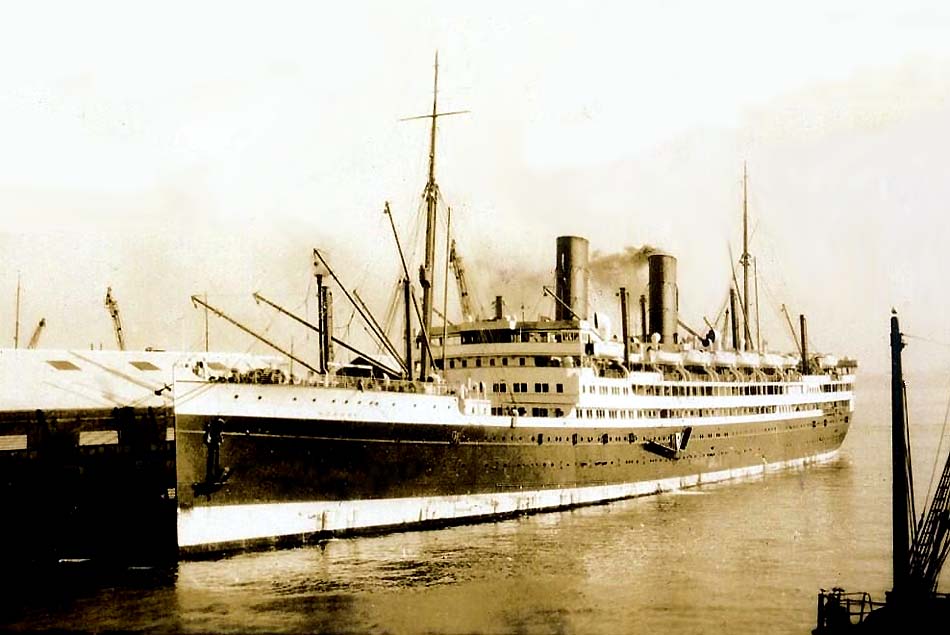
Here
we see the beautiful RMS Aorangi berthed at Queens
Wharf
having arrived on her maiden voyage a day earlier
This
photograph was taken on February 25, 1925 by David Ross’ father
As
the Aorangi gently pulled up to Queens Wharf the excitement commenced to grow
for this beautiful liner just seemed to tower above everything for she was so
large, compared to any other ship of her time and there was no doubt about it,
she was a wonderful sight to behold! All of Auckland’s
Newspapers hailed her with words such as follows;
“AORANGI’S ARRIVAL
Queen
of the Antipodes
Warm
Auckland Welcome
Spectators
Delighted with Pride and Patriotism”
“The
New Zealand
Herald”, Auckland February 25,
1925.
Another
paper had the heading,
“LARGEST
MOTOR LINER
THE
STATELY AORANGI
New
Era in Shipbuilding”
“The
Weekly News” Auckland,
February 26, 1915.
The papers wrote that “the ship was one
of the most handsome vessels afloat, having a straight stem (bow)
and a cruiser stern. Her two tall masts and two funnels give her a stateliness
that suggests a huge steam yacht … In design and furnishing, the public
rooms would do justice to a West End Hotel. The First Class Dinning Saloon is a
handsome and spacious apartment designed after the period of Louis XIV. The
First Class Lounge has a Georgian scheme of decoration and the Smoke Room
conforms to the Jacobean period. Two Verandah Cafes have been treated as garden
cafes, open to the principal Promenade Deck. In a word, the entire appointments
maintain a dignified elegance.”
The above is just a short excerpt taken from
the New Zealand Herald comments about their fine new ship, whilst she was
berthed in Auckland!
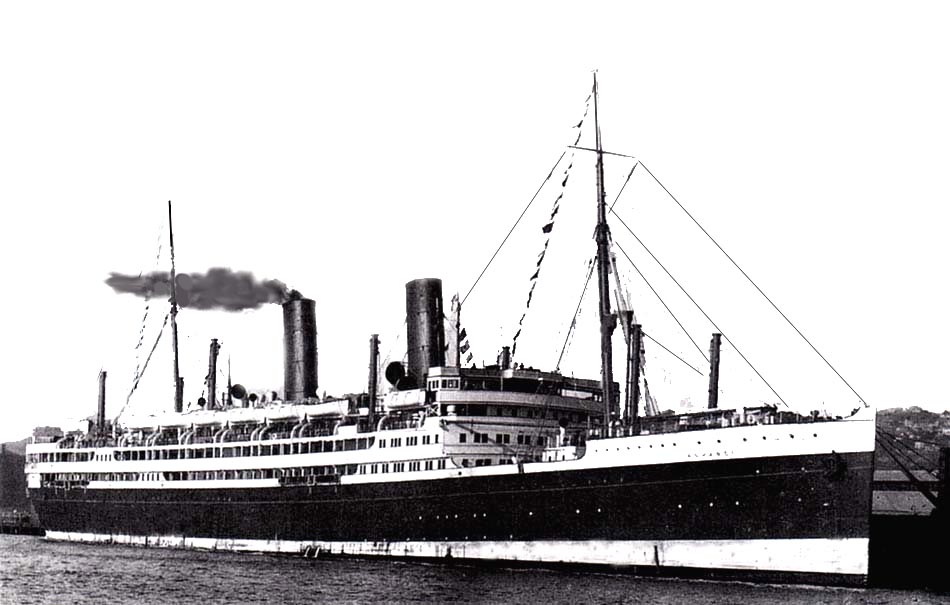
Another
delightful photograph of the elegant RMS Aorangi
Her
Career:
From Auckland as the Aorangi
was ready to sail, her passengers lined three decks and considering it was
during high tide the ship just seemed to tower high above Queen’s wharf
and there were countless streamers thrown from the ship to family and friends
on the wharf. And soon she was gone and out of sight!
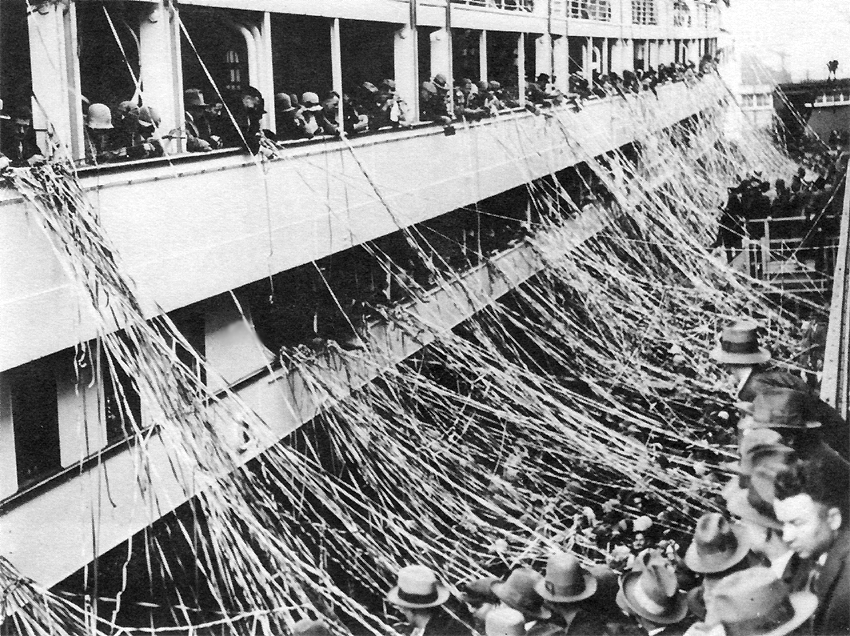
This
is a view from the second level showing Aorangi’s great height at high tide
She
headed across to the north of New Zealand, turned west,
and crossed “the Ditch”, better known as the Tasman Sea bound for Sydney
where she arrived on March 3, 1925. RMS Aorangi’s arrival in Australia
coincided with the “Jubilee Celebrations” of the “Union
Steamship Company of New Zealand,” therefore special events were held
onboard the ship, and due to the advance promotions, there was great deal of
interest in this new liner, by both the travel industry, the press and the
general public. She remained in Sydney
for five days and for several days the ship was opened up in order that special
guided tours could be held for the public as well as the press and dignitaries.
In the evening there were functions on board for USSCo management as well as
those who had been invited to these very special occasions. There would be a
meal in the First Class Dining Room, as well as entertainment and a speech or
two.
Five days later the RMS Aorangi departed for Vancouver she officially commenced on her
regular service, sailing her round voyages from Sydney via Auckland, Suva, and Honolulu to Vancouver,
where she always remained for five days. She would then depart Vancouver sailing via Honolulu, Suva, Auckland to Sydney
where she also remained for five days. Later San Francisco
would be included and schedules would alter somewhat!
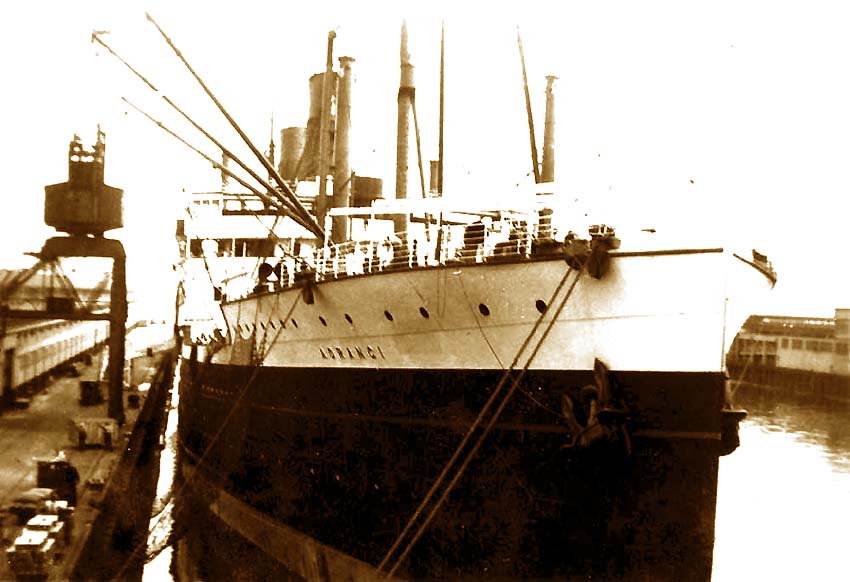
The
Aorangi is seen berthed in Vancouver
Over
the next six years the Aorangi
proved to be exceedingly popular operating the Trans-Pacific service, for her
passenger loadings proved remarkable. There was no doubt that travellers
enjoyed the luxuries this fine ship offered, even passengers in Third Class,
were delighted as they felt that facilities were superior to most other ships
on the Pacific! The voyage was a relaxing one giving ample time for friends to
get together and chat, or play cards, or just sit in a lounge, or in a deck
chair and read a good book, which many did, as well the many sport activities
that were available. However by 1931, a slight change would happen to the
company makeup!
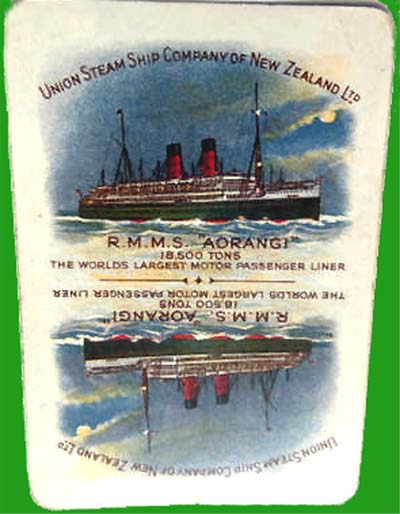
One of Aorangi’s playing cards, although
the printers over estimated
the tonnage just a little -
well by an additional 1,000 Tons!
A Minimal Change:
In 1931 the ‘Canadian Pacific
Line,’ purchased 50% ‘Union Steam Ship Co., of New Zealand’ (USSCo)
and together they formed the ‘Canadian Australian Line’ especially
for the Vancouver
- Sydney service. Thus
the MS Aorangi as well as the smaller 1913 built SS Niagara were
transferred to this new “CAL”
Line, but the ships continued to be operated by the USSCo of NZ, with the ships
retaining their traditional green-hulled livery and New Zealand
and Australian crews!
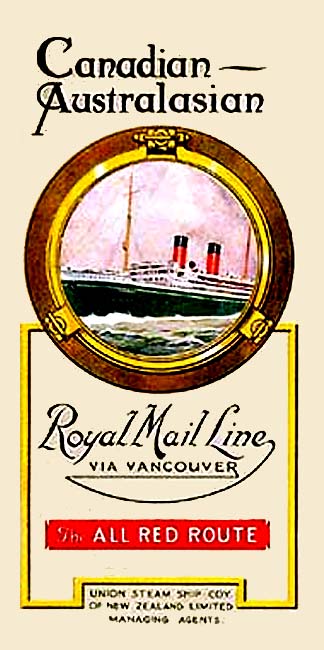
The
first Canadian Australian Line brochure from 1931
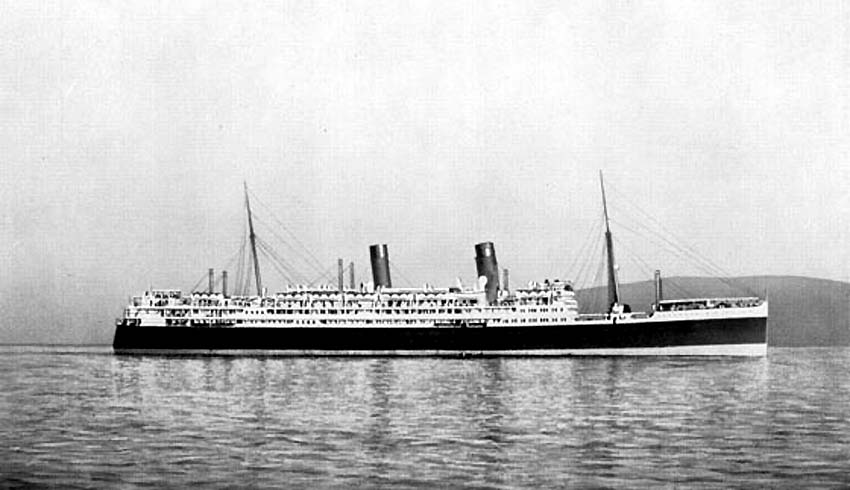
A
wonderful broadside view of the Canadian Australian Line ship
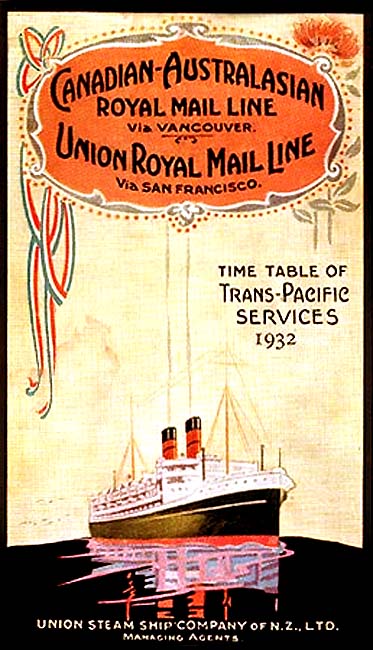
1932
Canadian Australian Line fares & Schedules for the Aorangi and Niagara
In
1938 she was given one of her regular overhauls, however this time it was
decided to make a number of changes to her accommodation. Upon completion there
were 248 First Class, 266 Cabin Class and 125 in Third-Class, thus in total
there were 331 less passenger’s berths available and now Second Class,
like Trans-Atlantic liners, was designated Cabin Class. Third Class also received
a further improvement making it even more attractive and there was more space
per passenger.
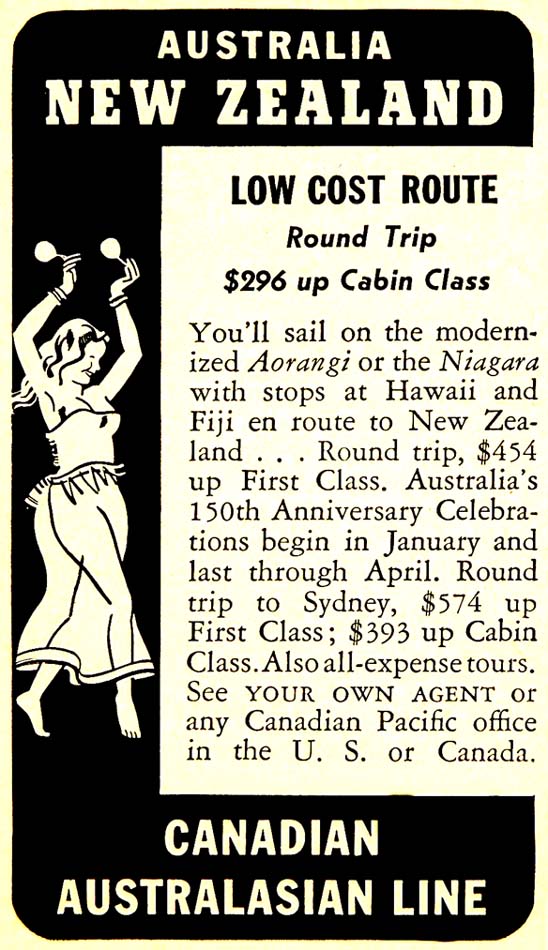
An
advertisement for the RMS Aorangi and the SS Niagara
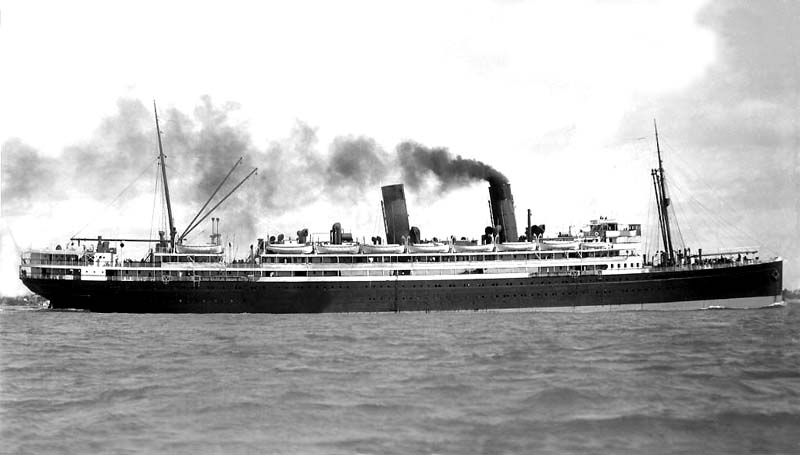
The
smaller, but similar looking SS Niagara, built in 1913
She sadly
sunk off New Zealand
1940
Provided by David Swimmer NZ – but photographer is unknown
– See photo note at bottom of page
World
War II:
In October, 1940 with the war already raging
in Europe the Aorangi still a passenger liner departed New Zealand filled with
troops for Fiji. Then up to the end of May 1941 the ship was transporting
troops and airmen from Australia to Canada.
But in June 1941 she was requisitioned by the British Ministry of War Transport
and the Aorangi sailed from Sydney
to the United Kingdom
in order to be converted for war duty. She received a rapid conversion, being
completely stripped from her luxury fittings and her lounges and large spaces
became large sleeping areas with countless hammocks or bunks. Although there
were a few smaller lounges retained for the officers and the
occasional passengers and whenever there would be some hierarchy on board!
Upon completion she was ready for duties and she was about to be caught up in
the midst of World War II. Amazingly, even though this fine ship was utilized
as a troop ship, a supply ship, a hospital ship and even an escape vehicle for
hundreds of civilians fleeing the war, the Aorangi miraculously emerged from the World
War II unscathed and she, like so many other liners, she finally met her end in
a breakers yard!
Soon she joined a convoy of
large liners carrying troops and supplies for the near east. Over time, she
carried troops to India,
the Middle East and also brought US and Canadian
troops to Europe
during the war, always escaping the torpedoes and the hunt of those German
U-Boats and searching bombers in the sky.
Then in January 1942 as the
Japanese had invaded Malaya, the Aorangi was sent in a hurry to Singapore
that had been already under heavy attack by Japanese aircraft. The liner
successfully managed to get into Singapore harbour and
escaped out of Singapore
with her interiors and decks completely packed with countless women and
children, and was able to safely transport them successfully to safety in Australia.
She had to head for France, as the Aorangi
would be offering a vital service as a depot ship for a fleet of about 150 tugs
and auxiliary ships, supplying them all with food, water, ammunition, engine
parts and relief crews. At the same time serving as a hospital ship and
providing medical supplies, and all this during the Normandy Invasion!
From D-Day, on June 6, 1944, until the end of
July, the Aorangi
managed to service some 1,200 vessels and countless other small craft. Her
hospital took in wounded men from the beachheads, she was a hard working ship and she had a superb staff and crew on her! But soon it
would all be over and she would be able to go home.
But it must never be forgotten that during the
war years, the amazing Aorangi
transported a good 36,000 troops and airmen and evacuated some 5,500 refugees
from war zones, but also treated countless medical cases and services other
craft and ships. She had a huge and a varied role during the war!
As soon as her main duties had been completed,
the Aorangi was converted to serve as the “Commodore ship” and she
joined the British Pacific Fleet in Hong
Kong in 1945. After the Japanese surrender, she was
berthed in Hong Kong
and was used as an accommodation ship for men released from war service and
awaiting their turn to go home.
On September 25, 1945 the Aorangi arrived in Brisbane
with 700 former Australian prisoners of war. Around one hundred would leave the
ship in Brisbane
and the Aorangi would arrive in Sydney
two days later with the remaining 600 heroic men. These were but a fraction of
the recently freed Australian prisoners of war that were to be recovered from
the territories formerly controlled by the Japanese.
Please Note:
See Page Two for further details of HMS
Aorangi’s wartime duties. A link is located at the bottom of this page.
Refitting an ex Warrior:
USSCo leased wharf No. 5 for
they decided it would be best to use this wharf and commence to restore and fix
the damage that had been done to her during World War II. She certainly needed
to be restored as a luxury commercial Passenger liner. Work began in June, however, it was severely delayed due to a massive
industrial action having been taken by engineers and dockworkers union in Sydney.
Initially the dispute was over the payment of ‘dirt’ money to those
working onboard the Aorangi,
during the war the men received dirt money for working in dirty places, and now
they said USSCo refused to pay it, because it was peacetime, the repair crews
left the ship at the end of June. This strike would continue until March 1947,
but finally work was underway and internally she was taking shape, but not as yet completed. With a dock available, the Aorangi was
relocated on June 30, 1947 to the Sutherland Dock, located at Cockatoo Island
where her much needed hull work was undertaken, and when completed, she had a
gleaming all-white hull, and she returned to Darling Harbour wharf No. 5 on
July 12.
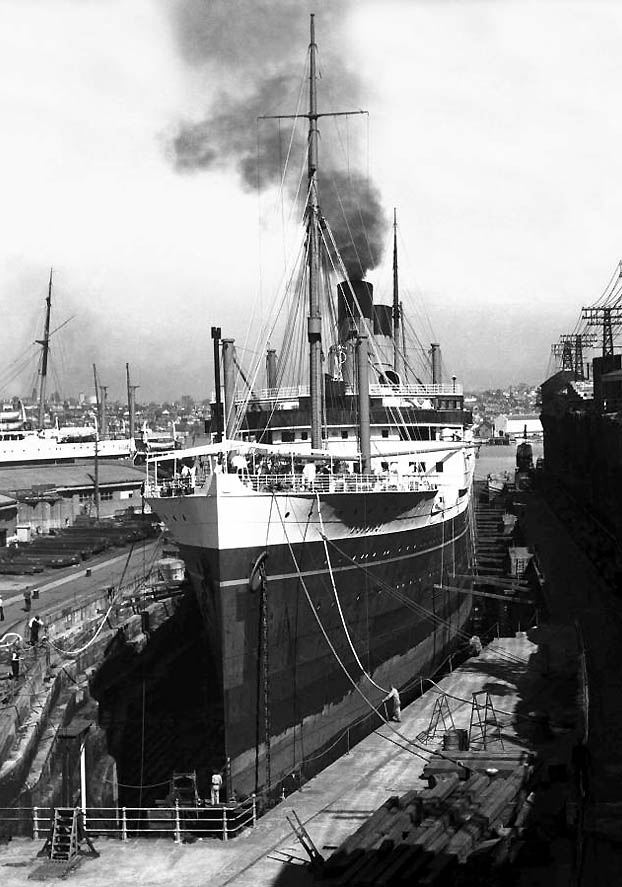
The
HMS Aorangi is seen in the Sutherland Dock, at Cockatoo
Island
in July 1947
Her
bottom would first be cleaned and made ready for her hull to be painted white
However, work on board would continue another
year before she was completed. The all-new looking liner headed out Sydney
Harbour
and out to sea for her engine/sea trials on Sunday August 1, 1948. The refit
cost around AuŁ1 million Pounds and it was fully paid for by the British
Government.
The now designated MV Aorangi was to resume
service in August 1948 with accommodations for 212 First Class, 170 Cabin Class
and 104 Third Class passengers for the Trans-Pacific service, or the Australia - Vancouver
service. Thus, the passenger accommodations were reduced by one hundred cabins
to create superior quarters for the crew. Thus, with her new hull painted white
with a green ribbon located around her hull. She departed Sydney on August 19, 1948 bound for Vancouver.
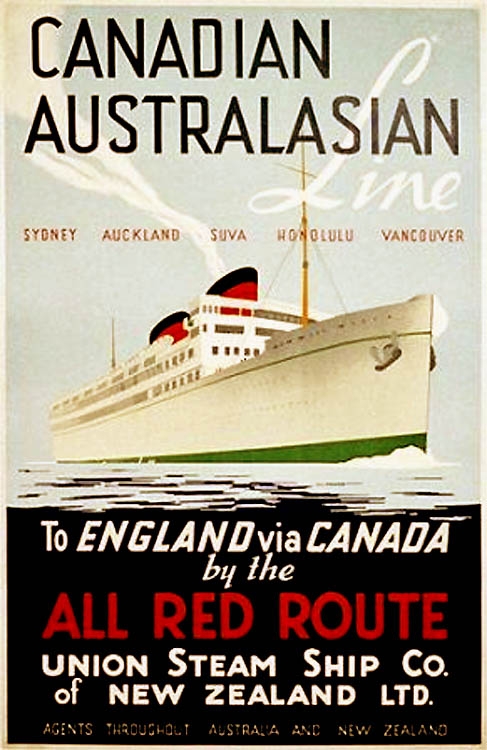
The
Company released a new brochure earlier in 1948 with details of an updated all
white MV Aorangi
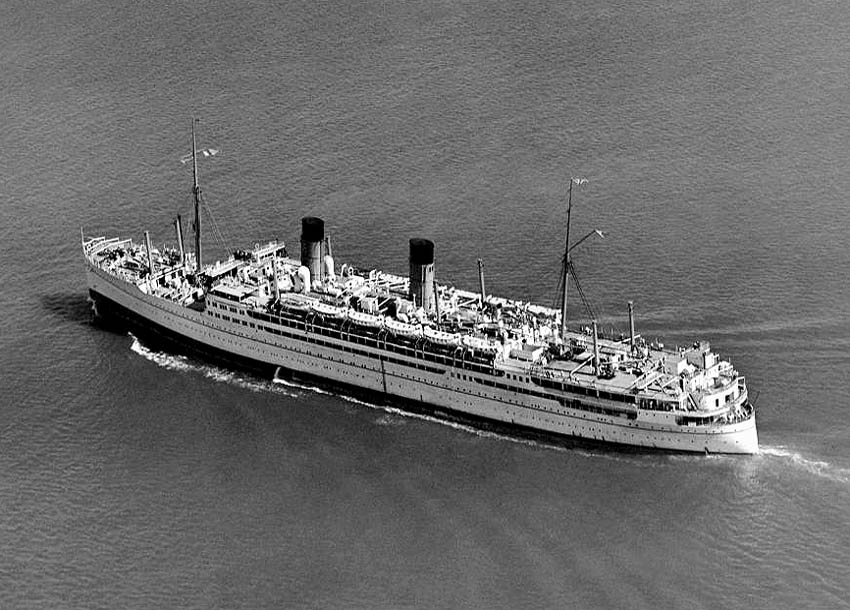
A
photograph of her in all new white livery
from 1948 and in 1949 she was returned
to her traditional USSCo green hull,
as the white did not prove to be popular at all!
Above
she is seen in Auckland
Harbour
on Dec 26, 1948, having returned from the Americas
Photograph
taken by Whites Aviation Ltd, but from the author’s private collection
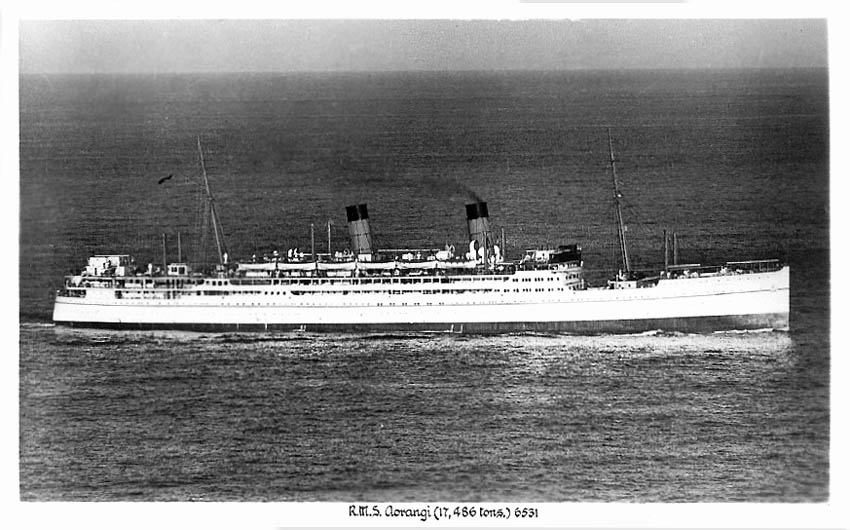
An
USSCo Postcard of the white RMS Aorangi from 1948
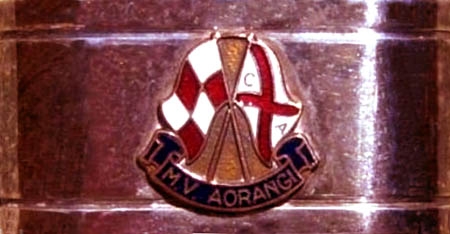
An item of
memorabilia; a sterling silver Napkin Ring from the MV Aorangi from around
1948/49
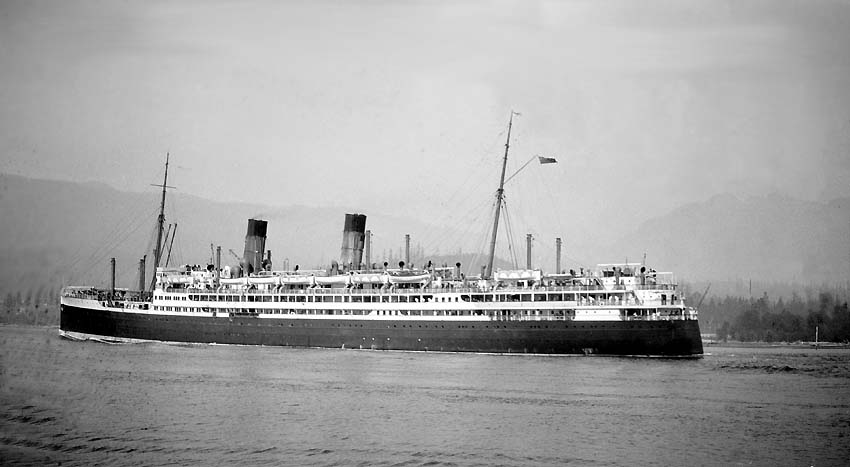
A
delightful stern view of the wonderful GREEN hulled, and again designated RMS
Aorangi in 1949
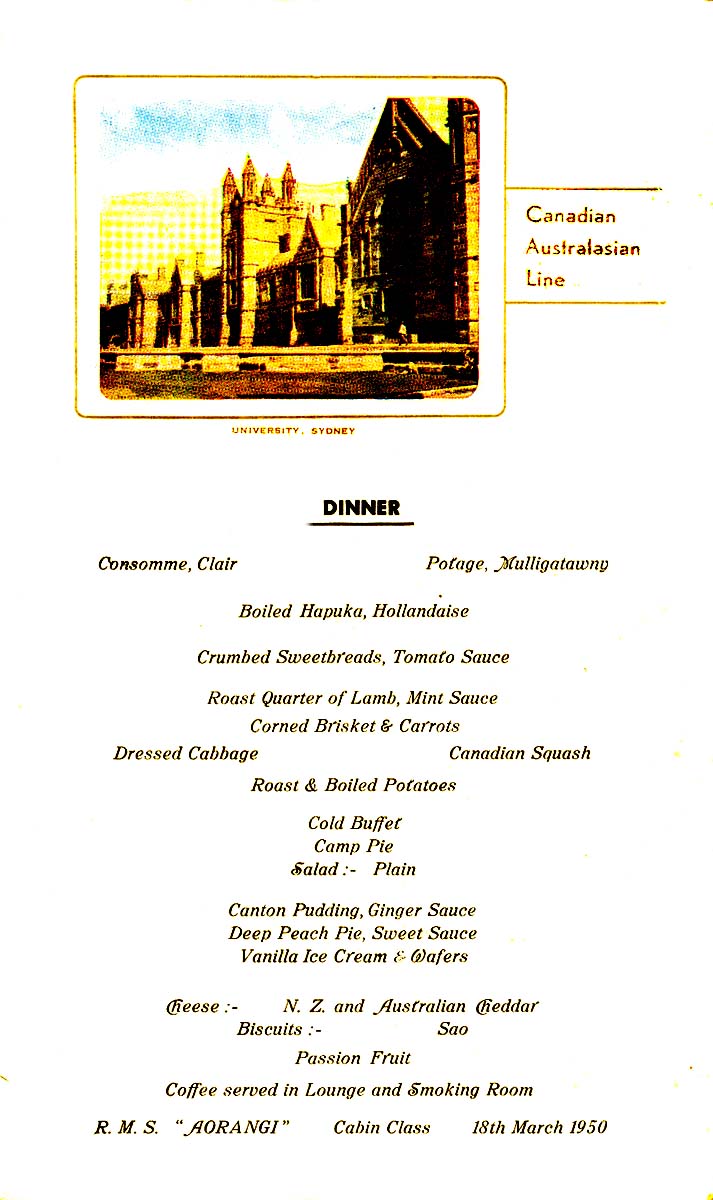
A
Cabin Class Diner Menu offering an excellent menu!
Aorangi’s Final Year:
Early
in July 1952, it was announced that the Aorangi would be tied up in “Kerosene
Bay”
in mid July for some two months, and there she would be undergoing a
Lloyd’s survey. The Aorangi arrived from Vancouver on July 12, and was set to resume the
Sydney, Auckland to Vancouver
service on September 25, 1952.
But then, with the Aorangi having departed as
scheduled, suddenly without notice just four days after she had left Sydney, on September 29, 1952 it was officially
announced that the MV Aorangi would be ending her service between Vancouver and
Sydney after she completes her voyage to Sydney
on May 25, 1953. This decision would have Australia and New Zealand without a
regular passenger liner service to North
America.
The Union Steamship Company of New Zealand, as agents for
the Canadian-Australasian Line, announced that the reason to discontinue the Aorangi was due to her age. They said that
the liner was now 28 years old and “that operation of the Pacific service
beyond May 25, 1953, could not confidently be maintained.” Already Matson
Line had been in Australia
a year earlier and has stated that they were considering either building or
buying two smaller much modern passenger ships for this service, thus the aging
Aorangi
could never compete with these ships!
Whilst departing her berth at Auckland on September 30th the Aorangi was delayed for sixteen hours when
she lost a gun port door whilst leaving the wharf. She was moving from her
berth when the door swung open, fouled a wharf-pile, and dropped into the
harbour. A plate was welded over the hole, and she left for Vancouver
in the afternoon. Permanent repairs will be made at Vancouver.
The Aorangi encountered a severe storm on
Monday October 27th whilst working southwards from Vancouver.
Winds of 80 miles an hour and 55 foot waves slammed at the Aorangi 800 miles
south-west of Cape Flattery as she headed out on her last voyage from
Australia. The vessel radioed the Dominion Public Weather office to report that
she was in the midst of a storm off Cape Flattery, the northernmost tip of Washington
State.
Two hours later it was reported the winds had 'dropped' to 55 mph. A huge wave
smashed windows and tore away woodwork. The wave hit the ship at 4 am flooding
the cabin of the master, Captain W. Whitefield, who was in bed. Crockery was
broken in the storm, which lasted 24 hours, Glassless windows and splintered
woodwork showed the effects of the wave, but much of the damage has been
repaired by the time the Aorangi
reached the next port. The Aorangi was two days late reaching Auckland, partly because of the storm and
partly because of engine trouble at Honolulu.
The last northbound sailing of 1952 for the
Aorangi should have left Sydney
in the last week of November; however the company delayed the date to December
11, reportedly due to engine trouble. There was then no prospect of Christmas
goodwill parcels and letters/cards now reaching America
before Christmas. The original schedule would have seen the Aorangi reach Vancouver
on December 19.
The Aorangi departed Vancouver for the very last time for Auckland and Sydney on Friday May 15, whilst bagpipes played
the “Skye Boat Song” and a countless steam whistles and sirens sais a typical Vancouver
goodbye to a dear old friend. With all the dignity of her 28 years, the MV
Aorangi moved under the famed Lion’s Gate
Bridge
as the Union Line / Canadian Pacific Railway's liner Princess Patricia
signalled a wistful “Goodbye and good luck” with her flags. Sadly
the Aorangi
did not have a full complement of passengers, around 70% full.
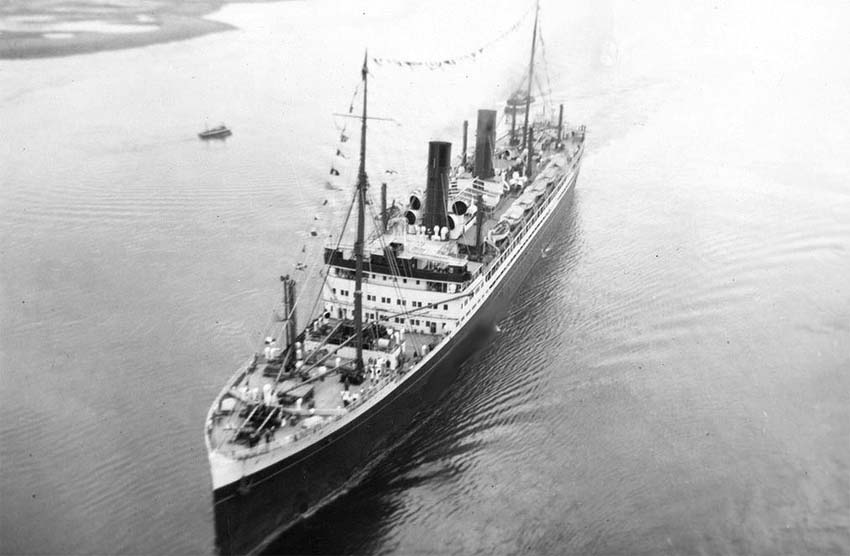
MV
Aorangi is seen under the Lion’s Gate (Bridge) Vancouver in 1953 as she heads for the UK
and the breakers
Amazingly
she still looked as good as new as she departed Vancouver,
but she was no longer cost effective
Then
on May 12, 1953 it was announced that the once great liner, the Pride of New
Zealand, the RMS Aorangi, would be sold and many hoped that she would have
another life sailing for another company, but that was not to be. For on June
9, when she was indeed sold, but to the British Iron & Steel Cooperation for
the sole purpose for her to be broken up in the United Kingdom!
As she returned to Auckland huge crowds came
to the wharf to see their much loved Kiwi ship, although she did spend a great
deal of time in Sydney, but people knew that this would be the very last time
they would ever see the darling of New Zealand again! She departed Auckland on June 4, 1953 with her final
passenger destination being Sydney.
However, her departure was delayed for around two hours, being due to a minor
mechanical fault, but it was soon fixed.
The Aorangi arrived in Sydney
on June 9, having just completed her final dramatic Trans-Pacific voyage. She
did arrive a day late being due to the ship having fought those fierce and
powerful westerly winds off the coast of Australia.
For the voyage between Auckland
and Sydney there were 366
passengers out of a maximum of 486, which was due to her
capacity having been lowered during her rebuild in 1946 and she had a
crew of 317.
Upon her arrival as the Aorangi berthed at No. 5 Darling Harbour, where
a huge crowd awaited her and they loudly cheered the ship. The ships at the
various wharves nearby gave a blast on their sirens as a greeting of welcome.
Ready to greet the ship was
Captain J G MacPhail, who was the wharf
superintendent, who back in February 1925 supervised Aorangi's berthing at No. 2 Circular Quay,
being her arrival during her maiden voyage. The master of the Aorangi, Captain
W Whitefield, said at his final Australian press conference on board that the
Aorangi had covered 1,300,000 Pacific miles during the nine years he has been
in command, and that two members of the crew had served 24 years with the
Aorangi, the chief radio operator, C F G Taylor, and the ship's barman, John
Gordon MacGregor. Mr. Taylor said: “The Aorangi seemed to bear a charmed life
throughout her career. Even an enemy flying bomb which fell into the sea 400
yards away failed to hurt her.” The chief steward, Mr. George Cooper,
said the Aorangi was the finest ship he had sailed in. “She is splendid
in bad weather,” he continued, “I am sad to see her going off the
run, but she is old and has given magnificent service.”
The Aorangi departed Sydney on June 18 for the breakers yard in Scotland
and technically she departed as a dead ship, stripped from all of her furnishings,
with no passengers or cargo on board, and she was manned by just a skeleton
crew. Interestingly, here had been a special draw for the crew of her final
voyage, and that had been done by the means of lots out of a hat outside the
shipping master's office. The reason that this draw was needed, was that there
were far more men who had volunteered for the voyage than was required for the
job. The truth is that crew looked upon this voyage more like a First-Class
holiday on full pay, for among other things, upon arrival in Scotland, there would be a
weeks holiday in the United
Kingdom before being flown back to Australia
thank you very much! A skeleton crew of one hundred signed-on the morning of
the departure. One of these men happened to be a cabin steward Mr. Harry
Hammond who was a member of the crew when Aorangi made her maiden voyage to
from Britain
to Sydney.
There was a great commotion as her lines were
freed from the shore by the dockworkers, and even the Orient liner the SS
Otranto that was berthed at an adjoining wharf flew a special signal of
farewell as the Aorangi
slipped from her berth for the very last time. All the way down the harbour
every liner in port, as well as freighters, ferries, and countless small
harbour craft sounded a friendly farewell on their sirens and whistles. Even
the Royal Australian Navy sent a wonderful farewell message from H.M.A.S.
Australia: “We are sorry to lose an old friend of many years standing in
these waters. Captain, officers, and ship’s company, wish you luck on
your last voyage.”
After Aorangi had cleared the Heads her
master, Captain W. Whitefield radioed to Sydney
the following message: “We are now on our last voyage to the ship
breakers yards. The ship is putting her best foot forward as though she is
telling us there is life in the old girl yet.”
After a smooth voyage via the Suez Canal, she arrived at the ‘Arnott Young’ of Dalmuir
West, Clydeside, for partial breaking on July 25,
1953. They commenced their work early in August But
then she was moved, see below for the final stages of this fine Liners demise.
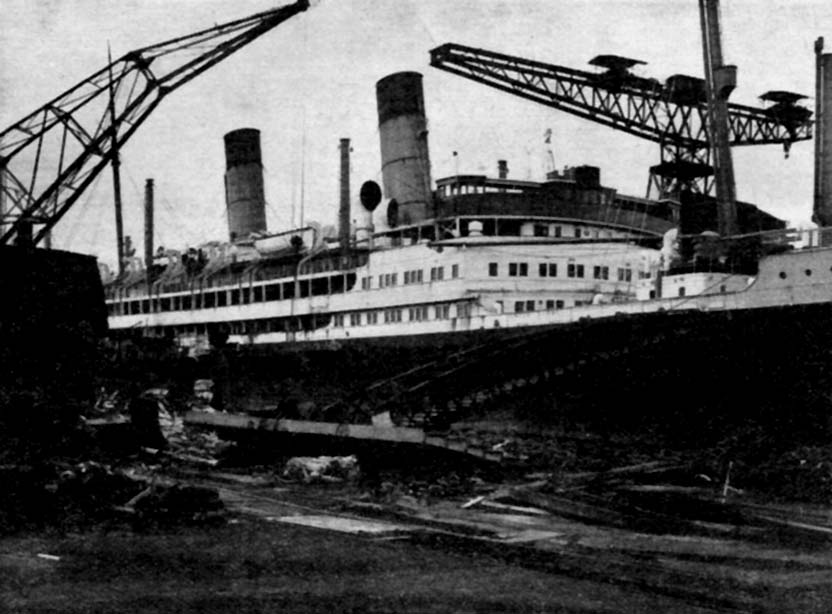
A
sad view of the Aorangi
at the Scottish breakers at Dalmuir
After
work at Arnott Young’ of Dalmuir
West, Clyde side had finished, her remains, the ships hulk was delivered to the
‘West of Scotland Shipbreaking Company Ltd’ of Troon
on April 6, 1954 and her breaking up commenced six days later on April 12.
Scrapping of the once great RMS Aorangi was completed, and she was now sadly
completely gone on September 20, 1955. Amazingly,
she was broken up not far from where she was actually built some thirty years
earlier!
**********************
Specifications as Built:
Built: Fairfield Shipbuilding
& Engineering Company, Glasgow.
Launched: 1924.
Delivered: December
1924.
Maiden
Voyage: January 2, 1925.
Tonnage: 17,491 GRT tons.
Length: 600 ft - 183.m.
Beam: 72.2 ft -
22 m.
Draught: 29.9 ft – 9 m.
Propulsion:
Four Fairfield-Sulzer 6ST70
two-stroke single acting 6-cylinder diesel engines 3000/3600hp at 130 rpm.
Auxiliary engines: Four x 4SS34 and one x 2RV24 totalling
1,660 HP.
Screws: Four.
Speed: 17.5 knots.
Passengers: 1925 - 440 Saloon,
300 Second-Class and 230 Third-Class.
. 1938
- 248 First-Class, 266 Cabin-Class and 125 Third-Class.
. 1946
- 212 First-Class, 170 Cabin-Class and 104 Third-Class.
Crew: 328.
Broken
up: August 1953 Arnott Young & Co on the Clyde Dalmuir,
Scotland.
& West of Scotland
Shipbreaking Company Ltd’ of Troon, completed
September 1955.
Distances between ports in Nautical Miles & Kilometres.
Southampton – Vancouver
via Panama
Canal: 8,746 Mi - 14,075
Km.
Vancouver - Honolulu: 2,383 Mi - 3,835.1 Km.
Honolulu
- Suva: 2,761 Mi - 4,443.4 Km.
Suva - Auckland: 1,251 Mi
- 2,013.3 Km.
Auckland - Sydney: 1,281 Mi
- 2,061.6 Km.
Let
Us Remember New Zealand’s
Great Liner ~ The …
RMS
Aorangi
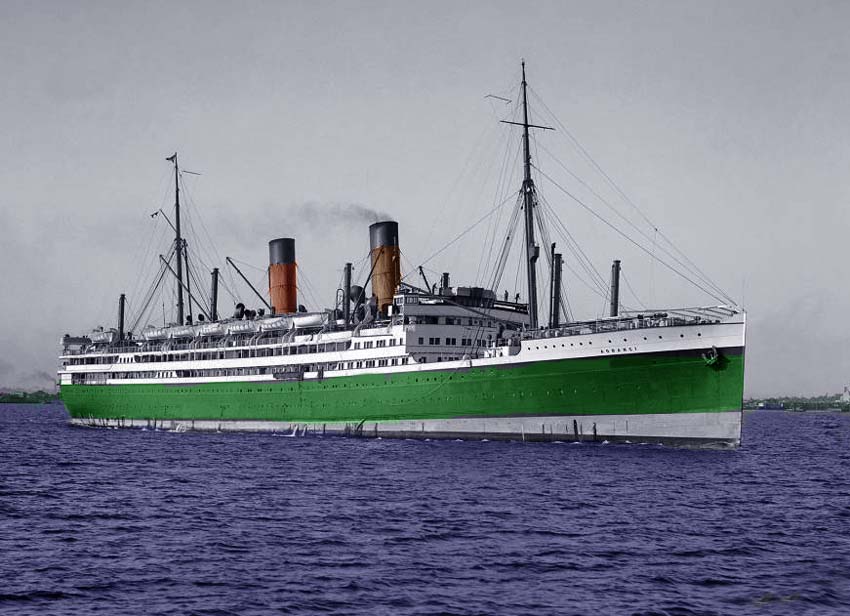
She
is seen in Port Phillip Bay, Melbourne
Photograph was colourised by the author
Also read Page Two - HMS Aorangi WW2 Duties
Also view the other USSCo Passenger Ships online, from
oldest to the last ever built
SS Waitaki / SS
Moeraki & Manuka / SS Marama & Maheno / RMS Aorangi
TSS Monowai / TSS Awatea / MV Matua
& MV Tofua
**********************
Use
the Back button on your browser or Close the Page to return to the previous
page
or go to our INDEX
ssMaritime.com & ssMaritime.net
Where
the ships of the past make history & the 1914 built MV Doulos Story
Photographs on ssmaritime and associate pages
are by the author or from the author’s private collection. In addition
there are some images that have been provided by Shipping Companies and private
photographers or collectors. Credit is given to all contributors. However,
there are some photographs provided to me without details regarding the
photographer/owner concerned. I hereby invite if owners of these images would
be so kind to make them-selves known to me (my email address may be found on www.ssmaritime.com only), in order that due credit may be
given.
This notice covers all pages, although, and I
have done my best to ensure that all photographs are duly credited and that
this notice is displaced on each page, that is, when a page is updated!
ssMaritime is owned and © Copyright
by Reuben Goossens - All Rights Reserved

















































